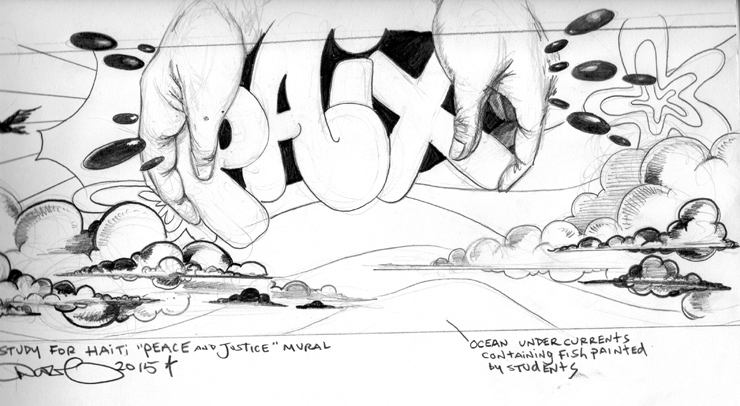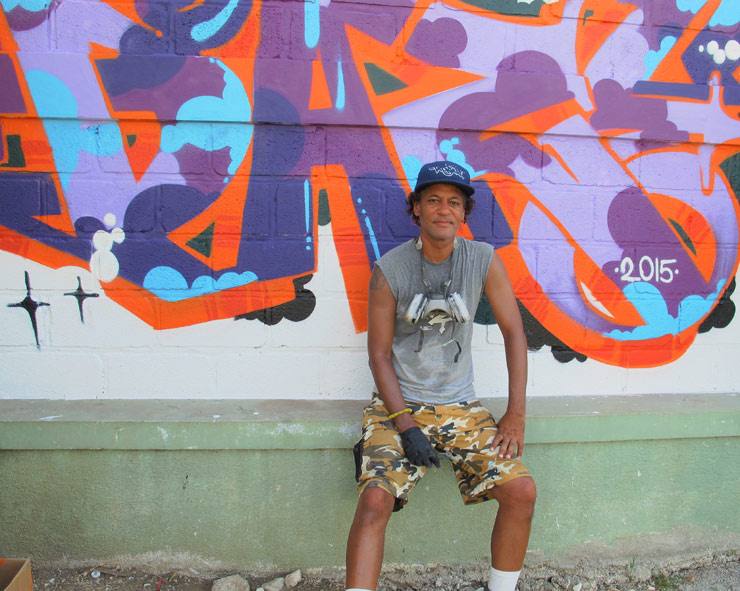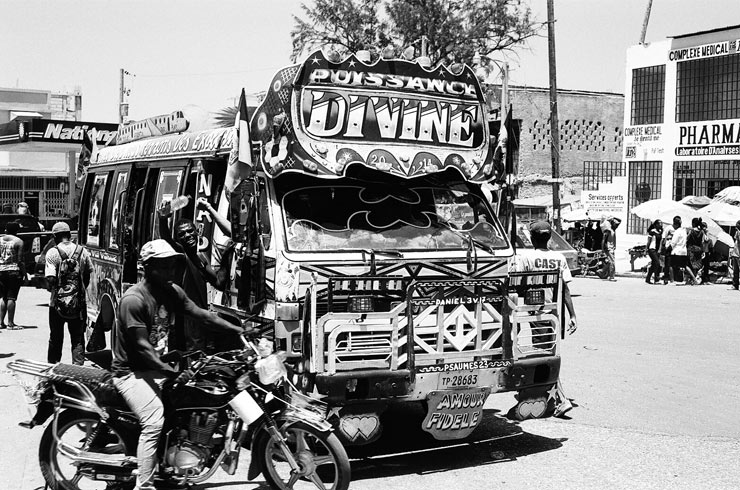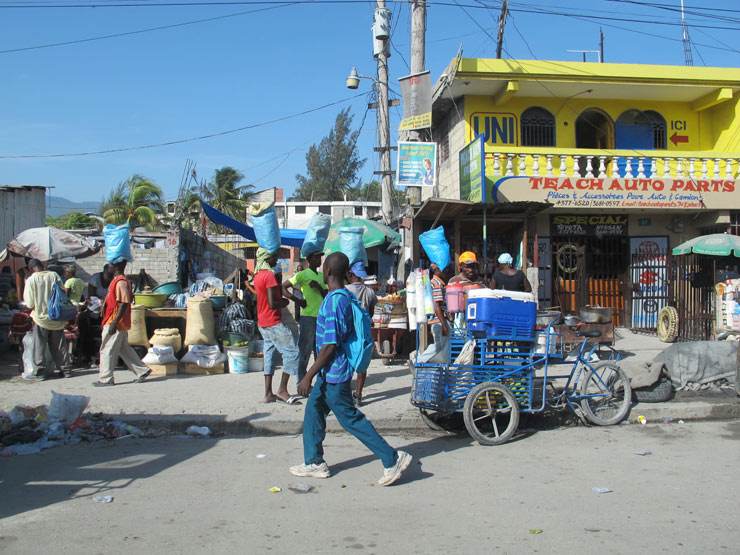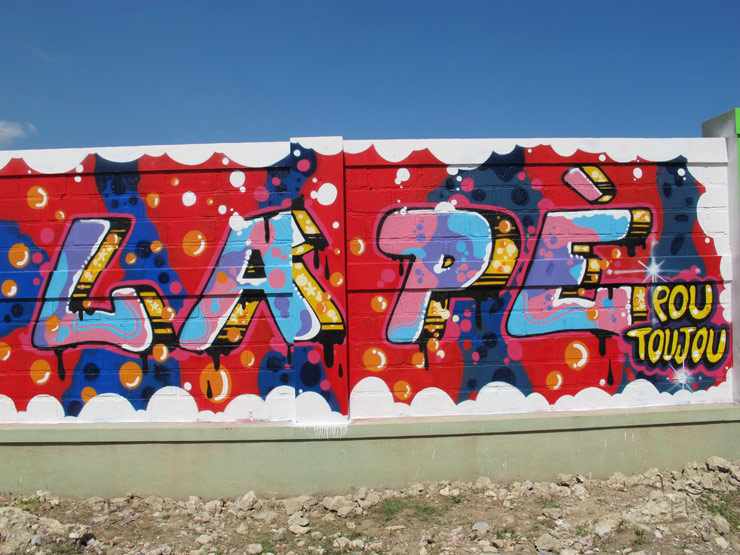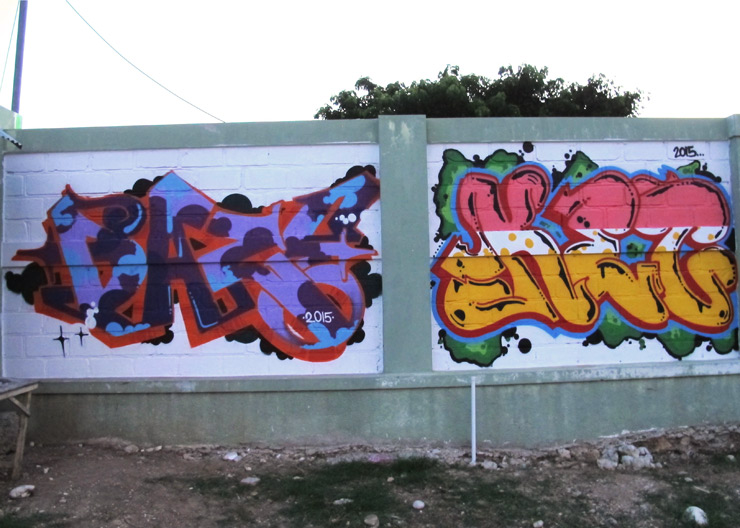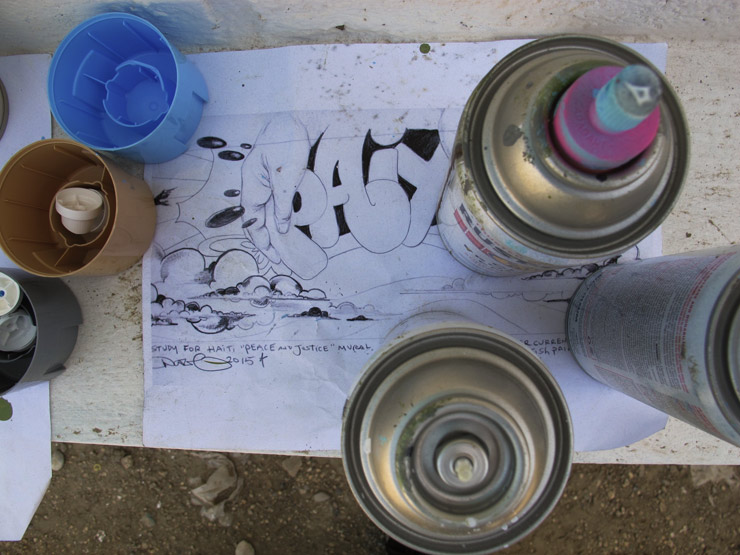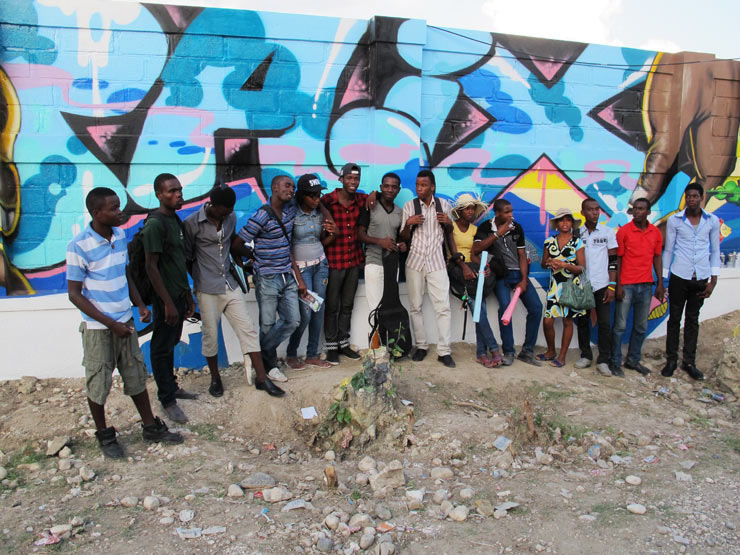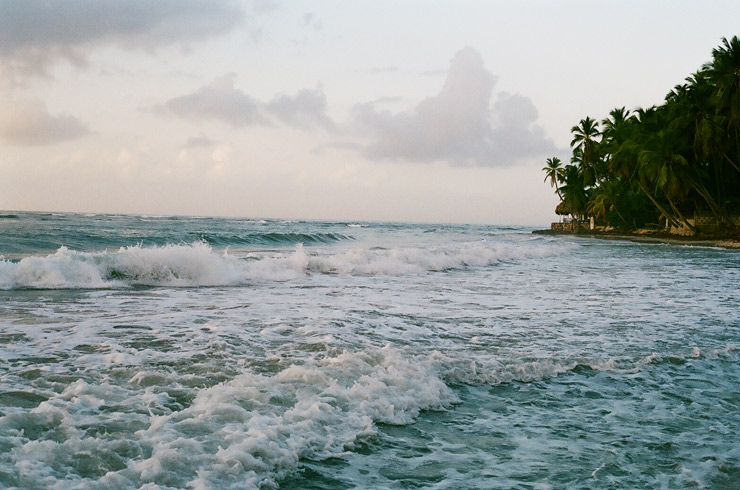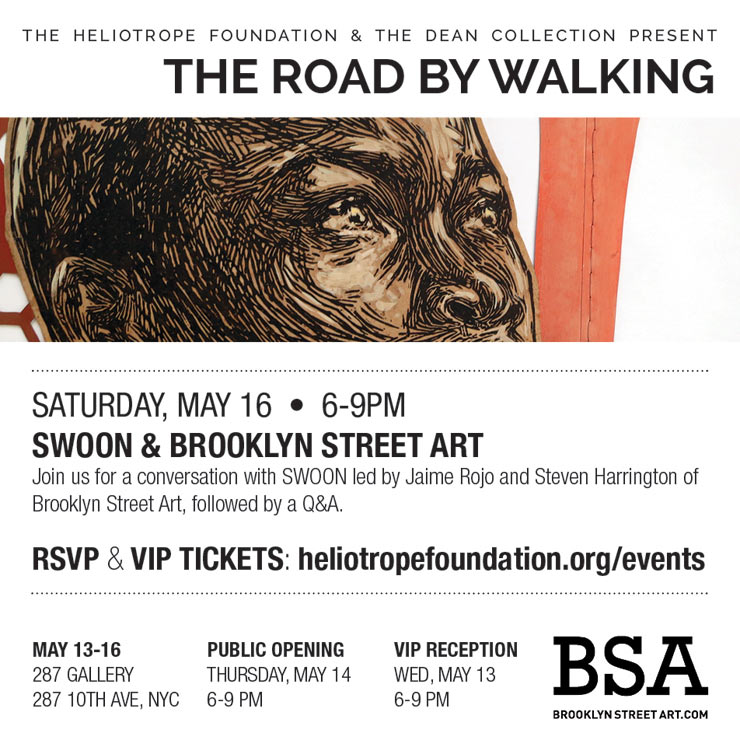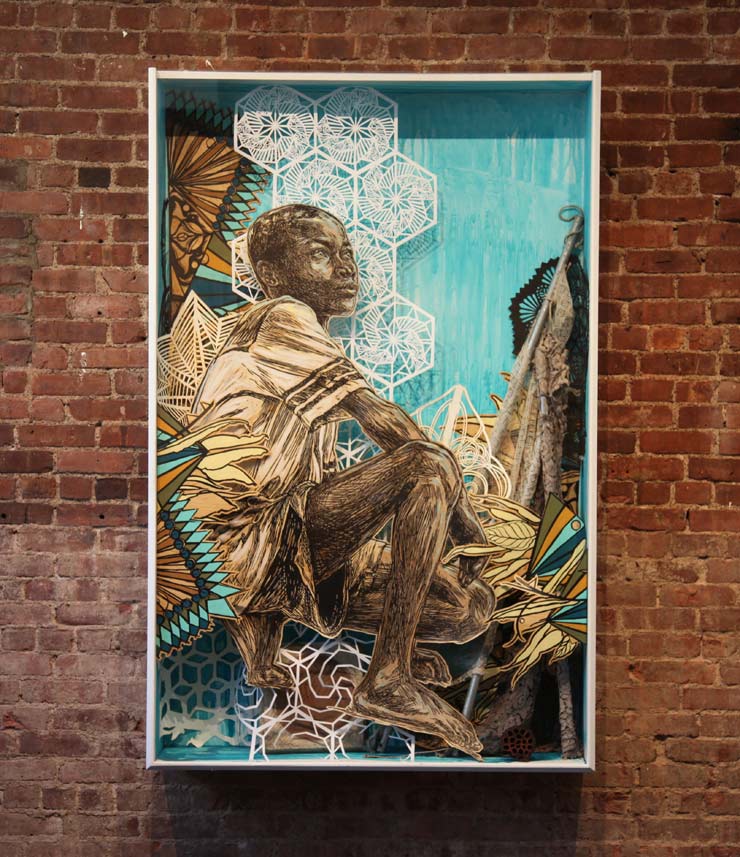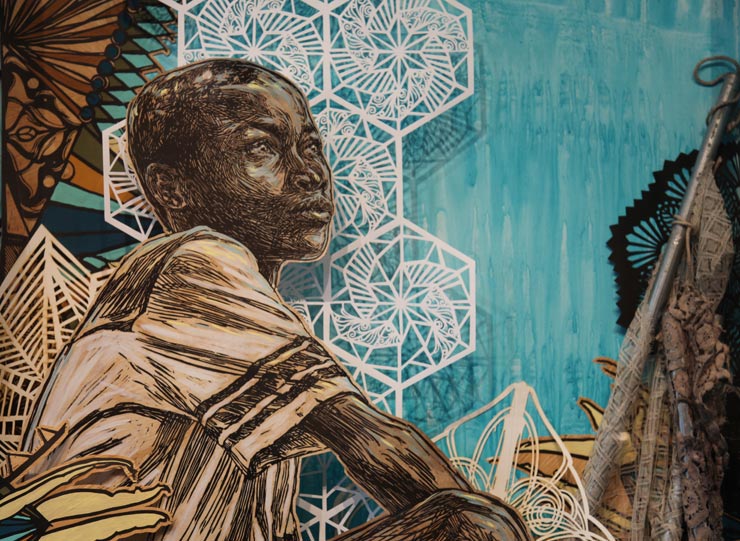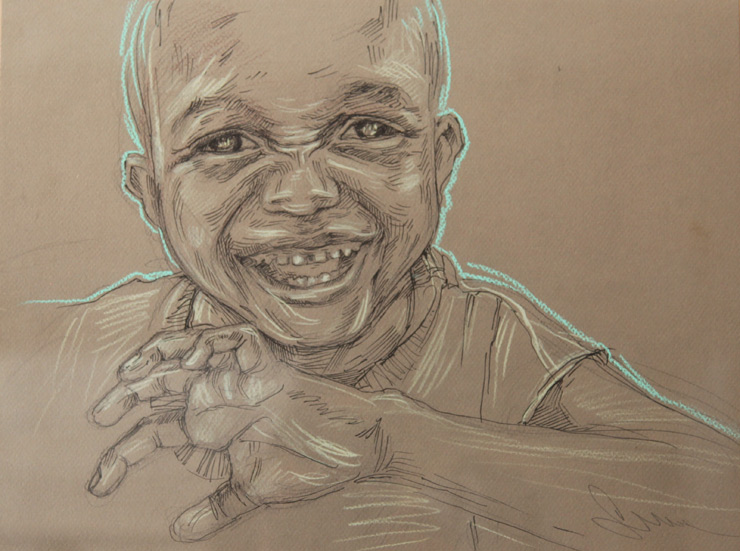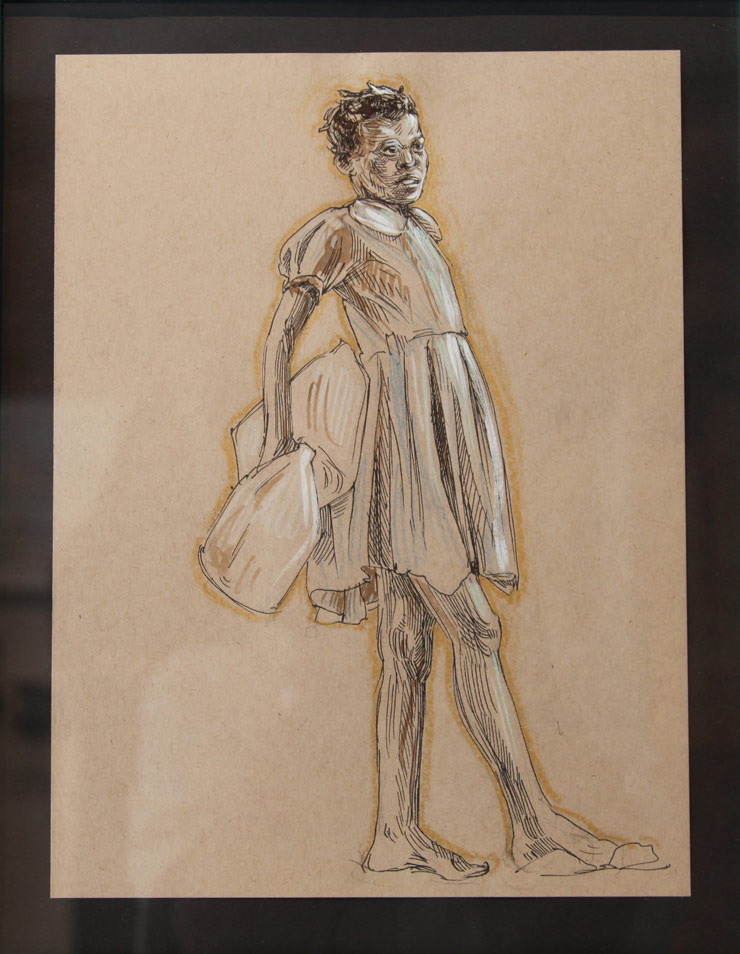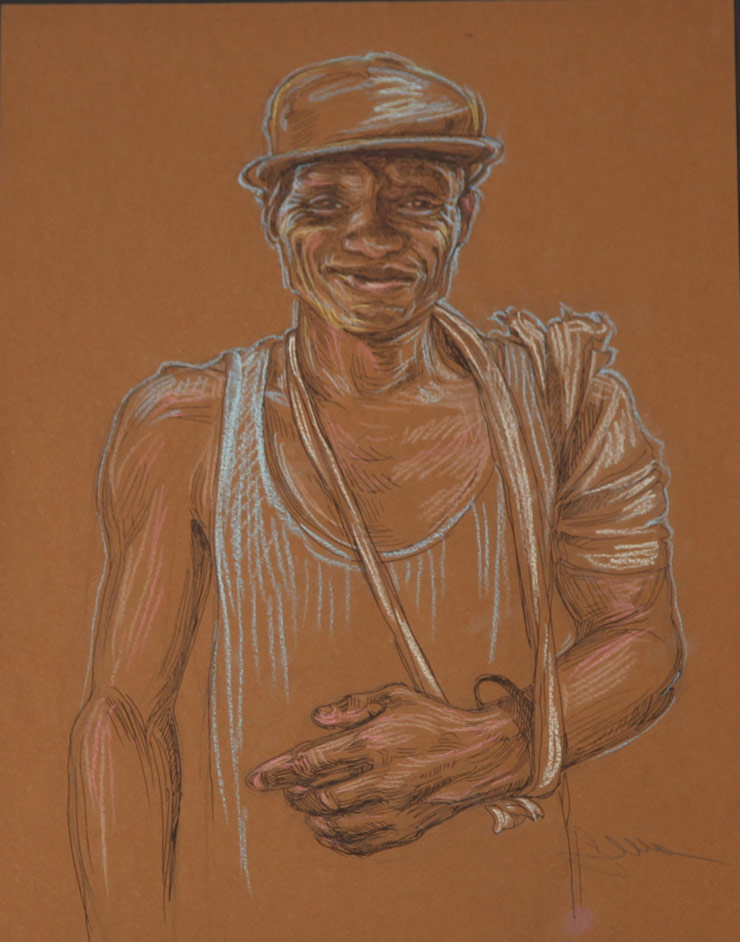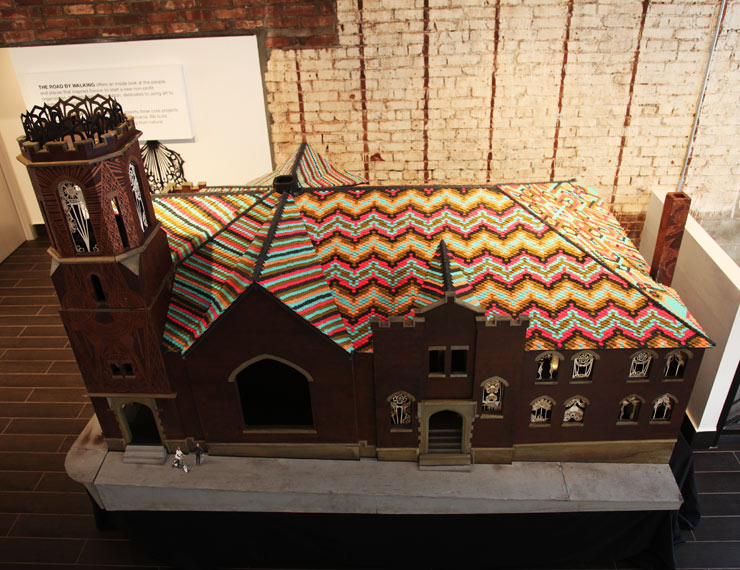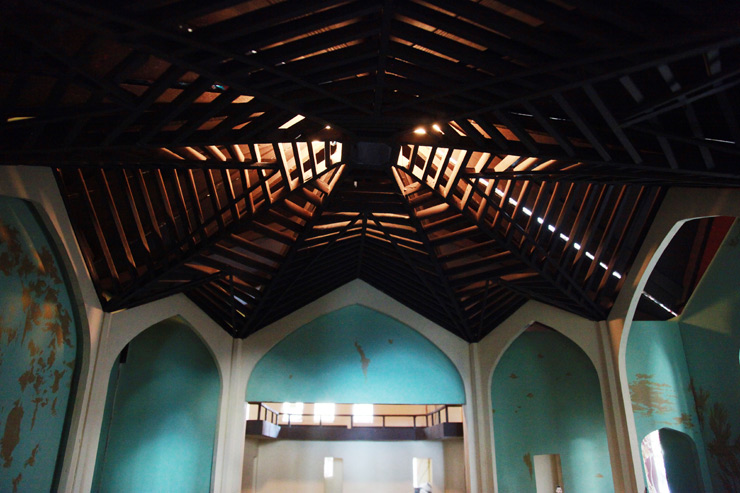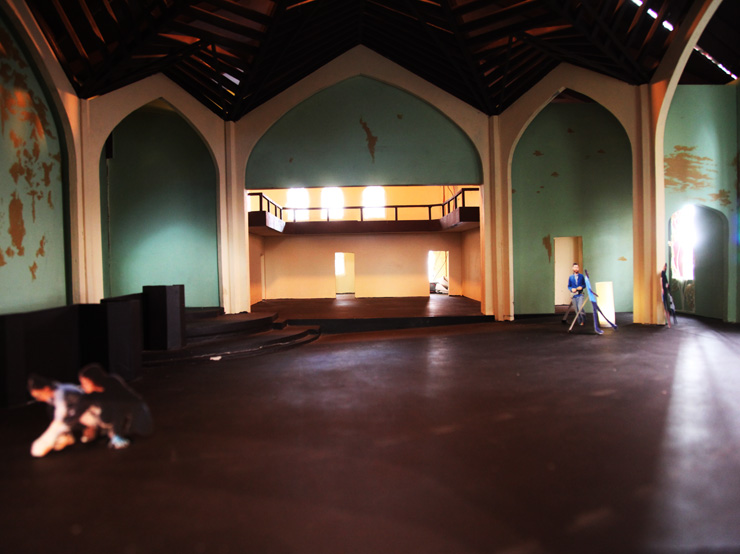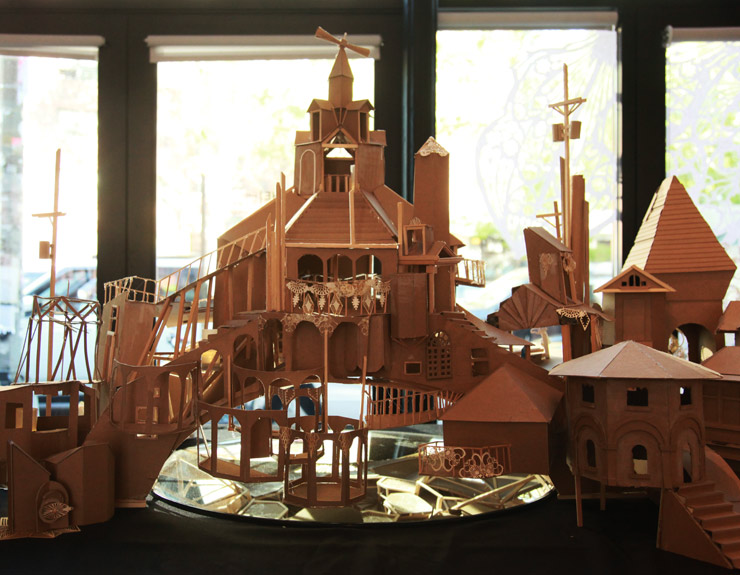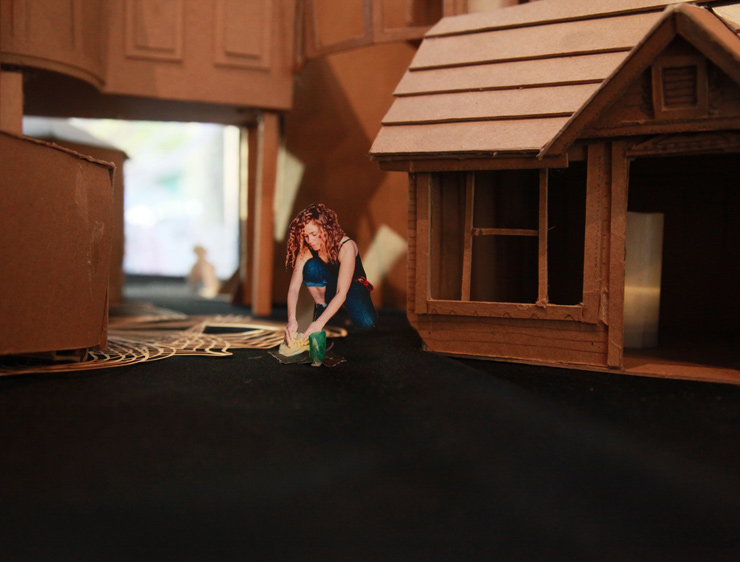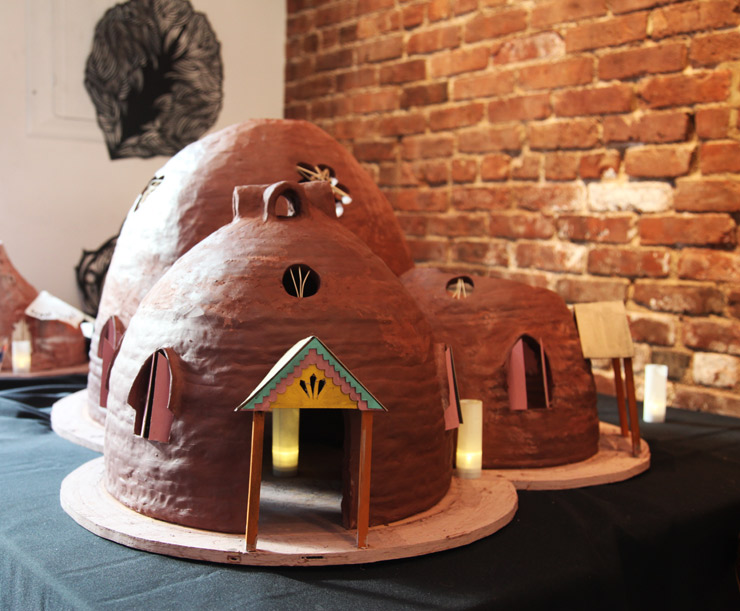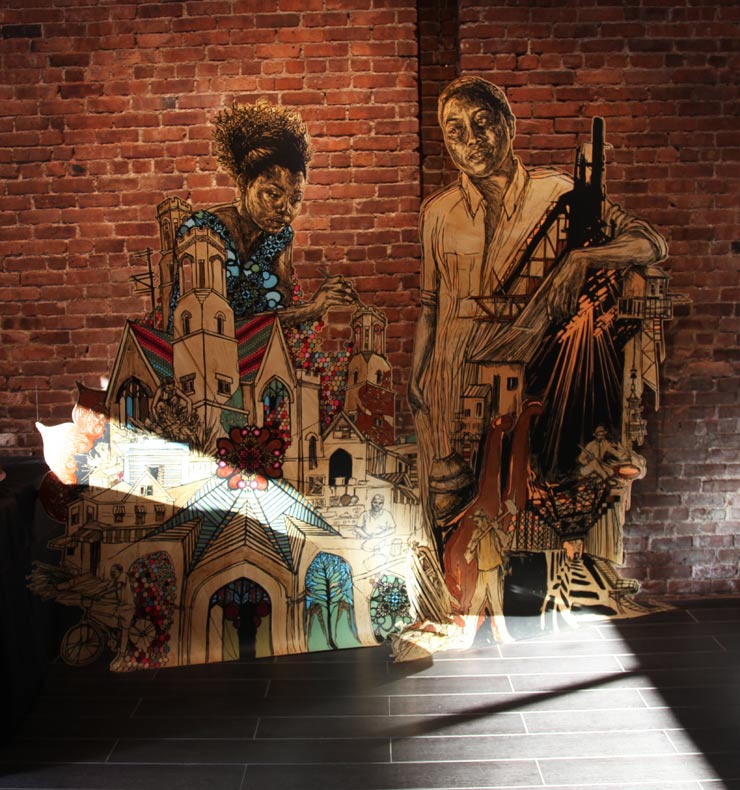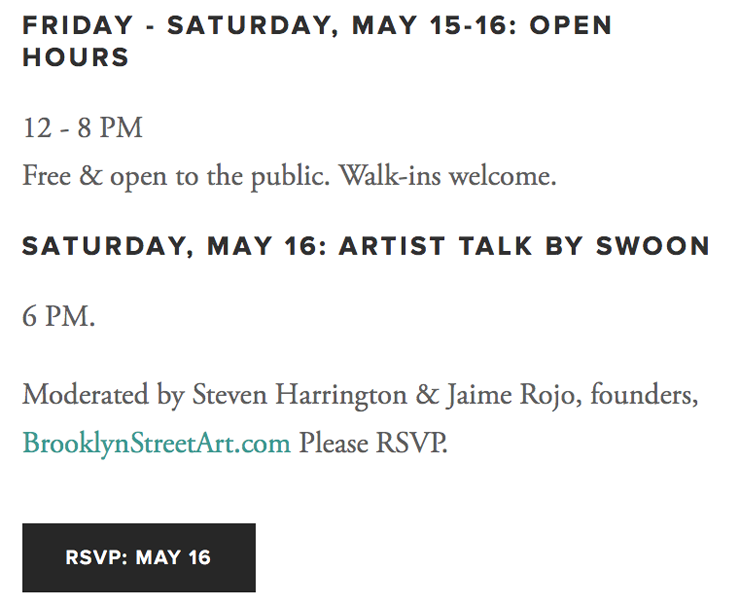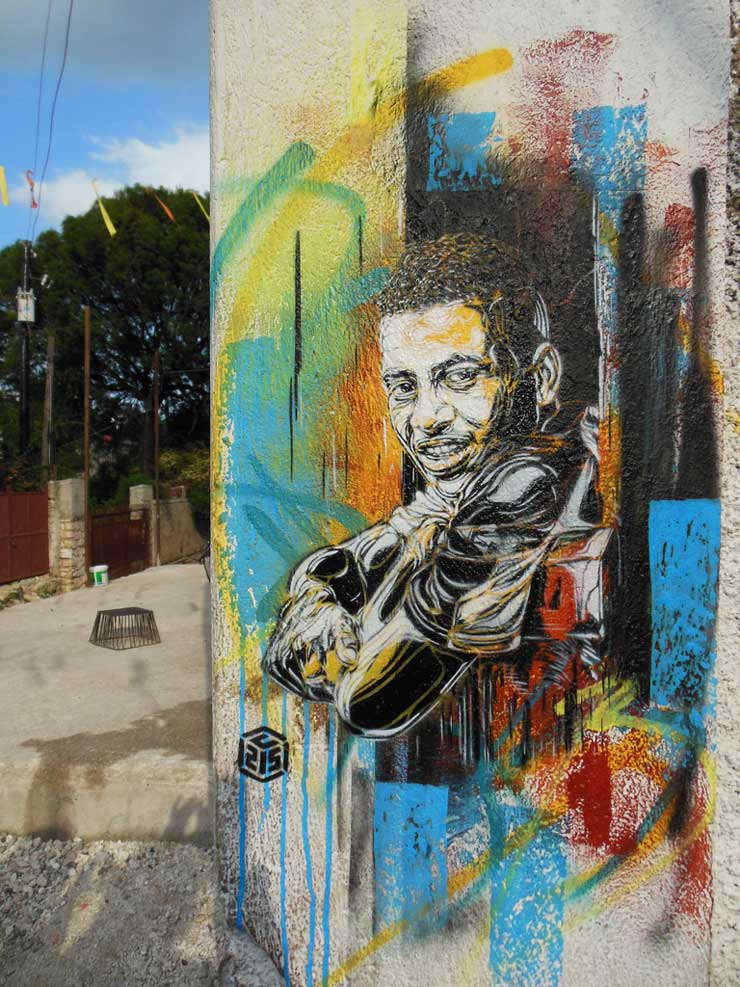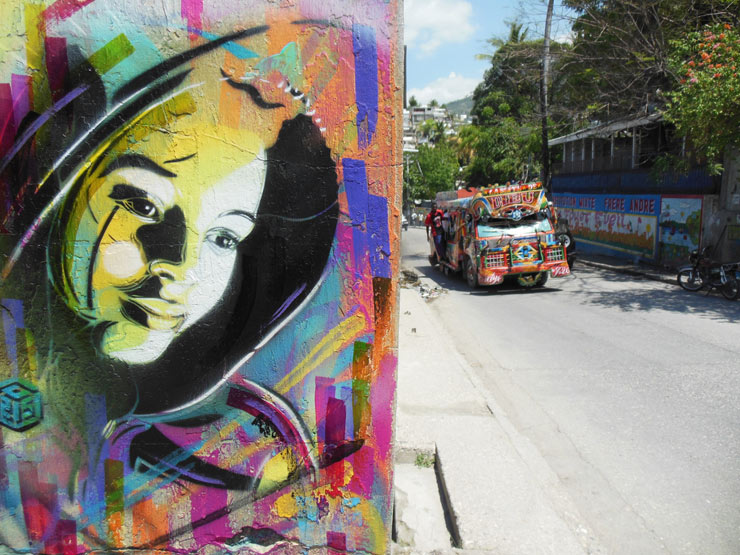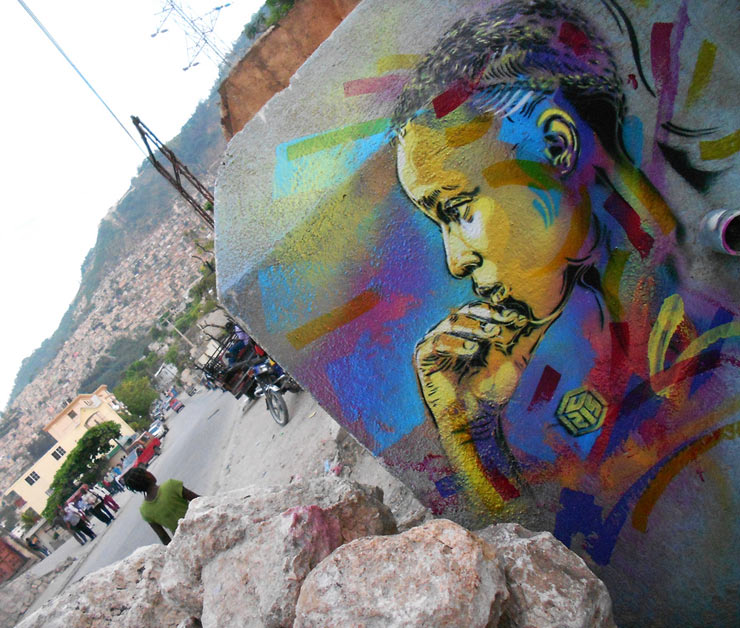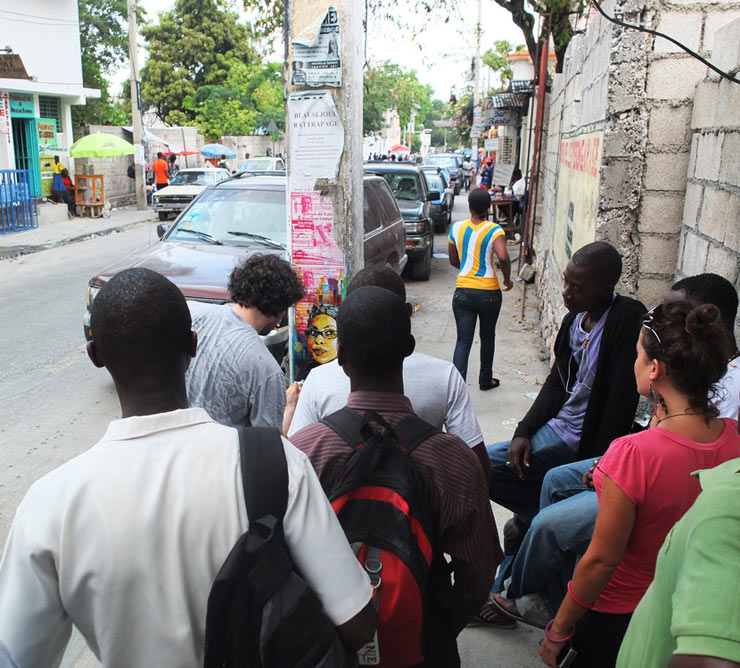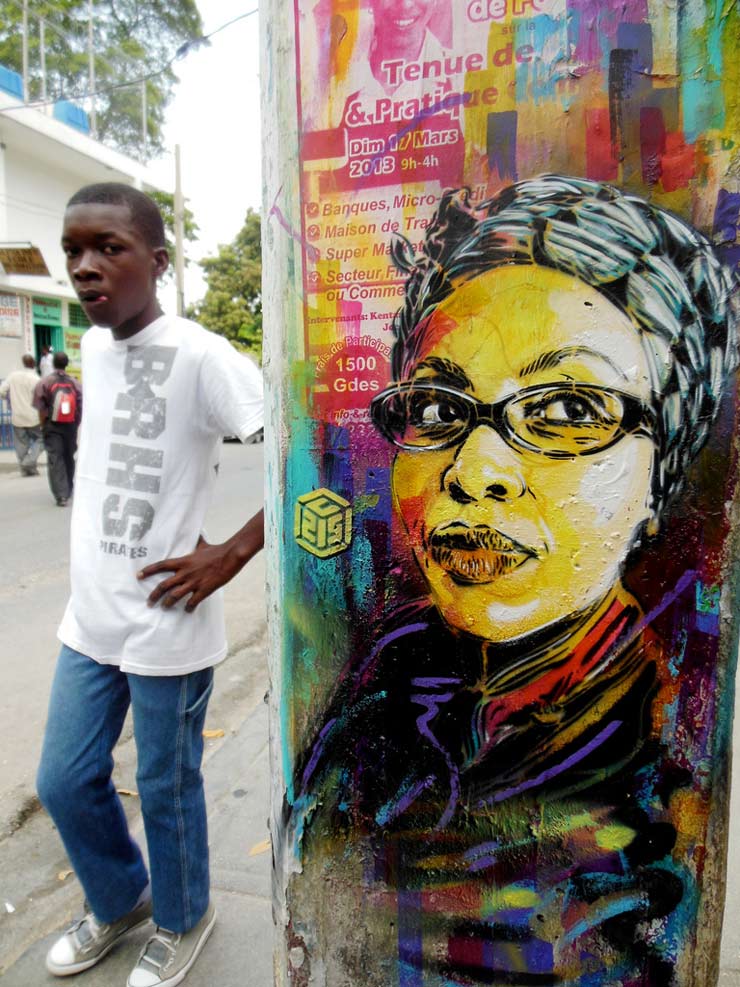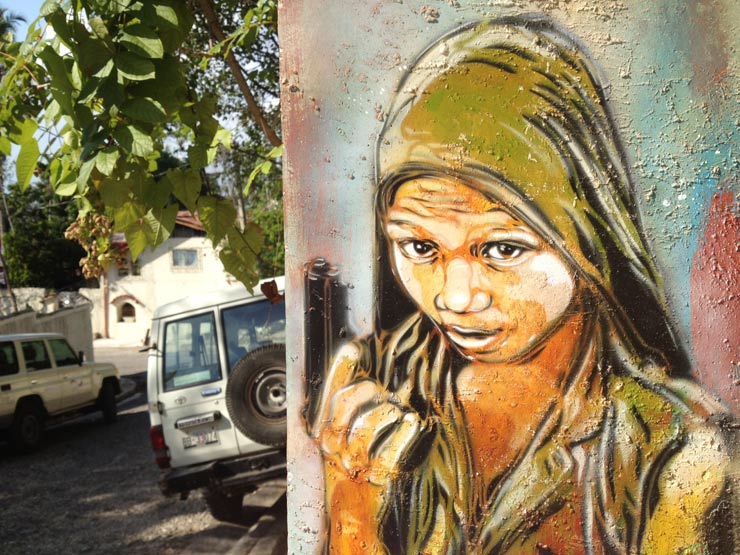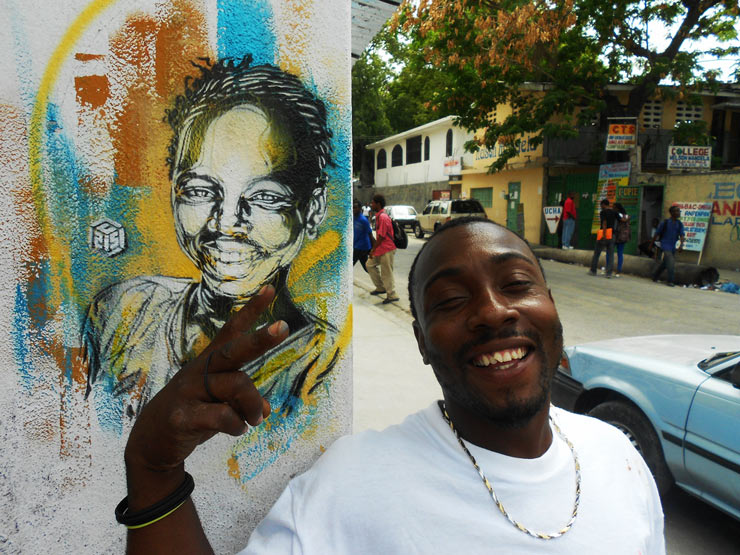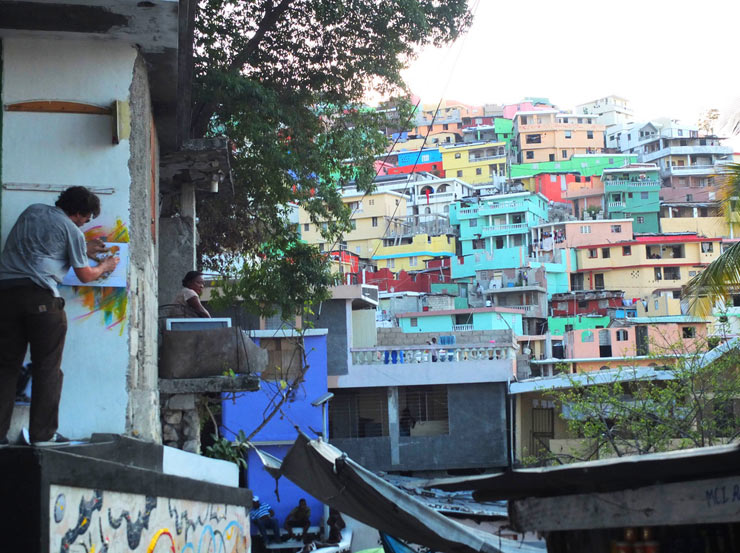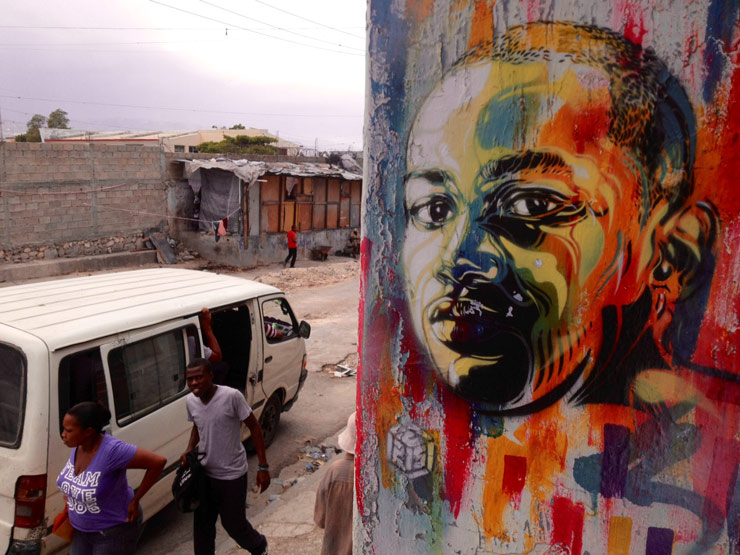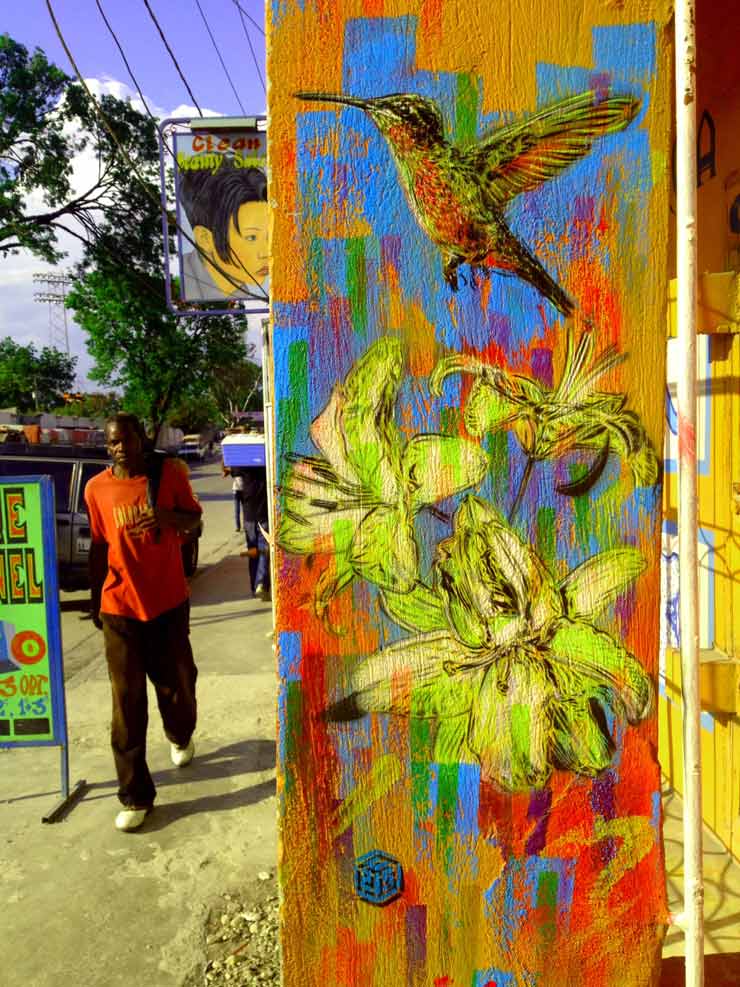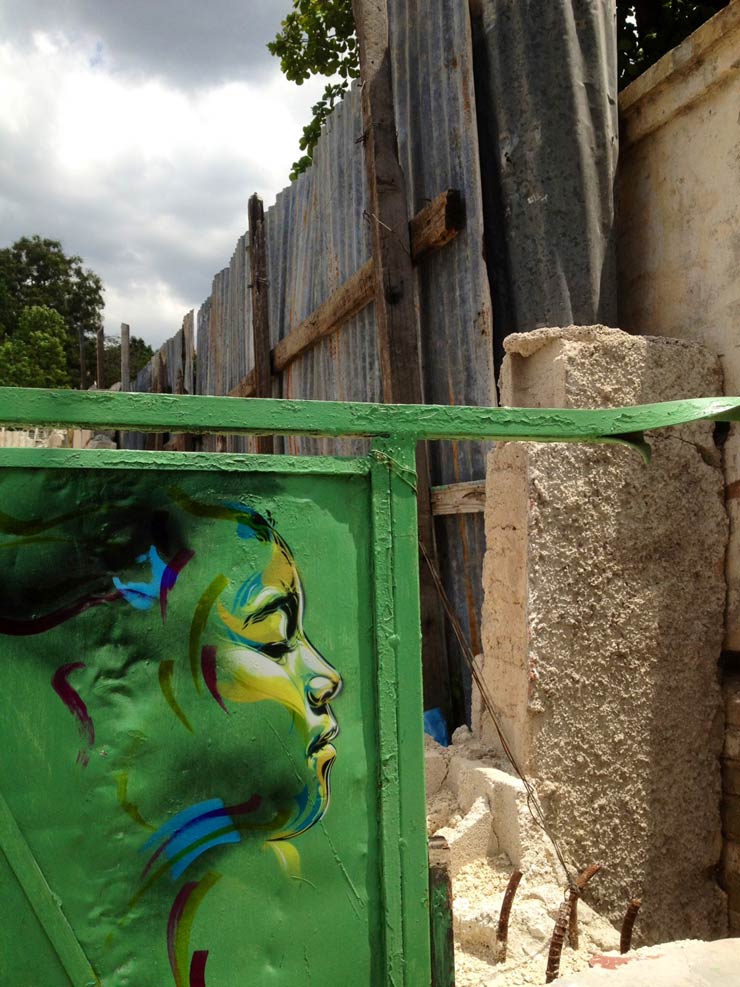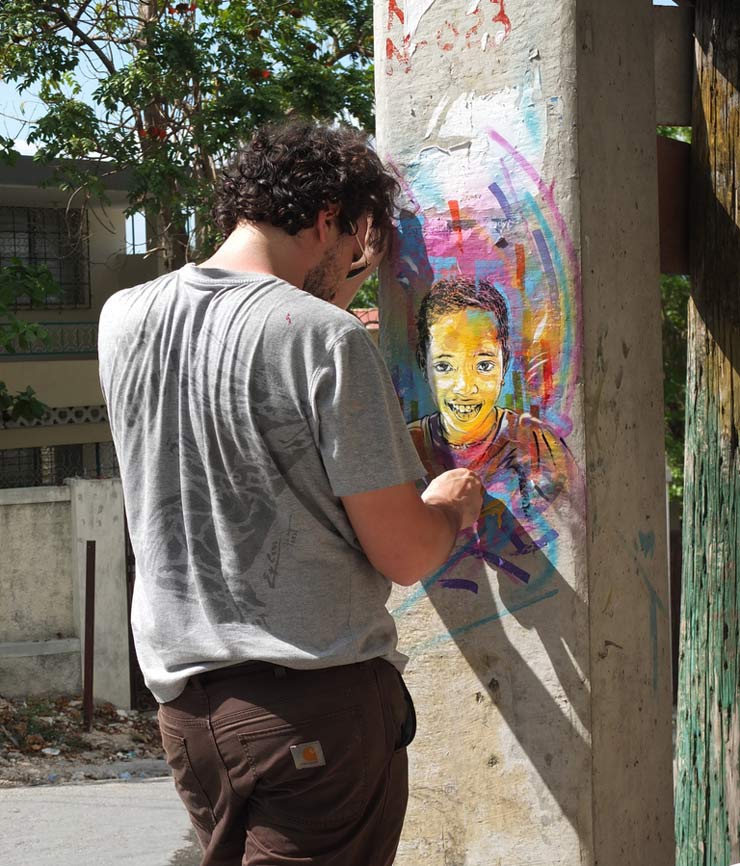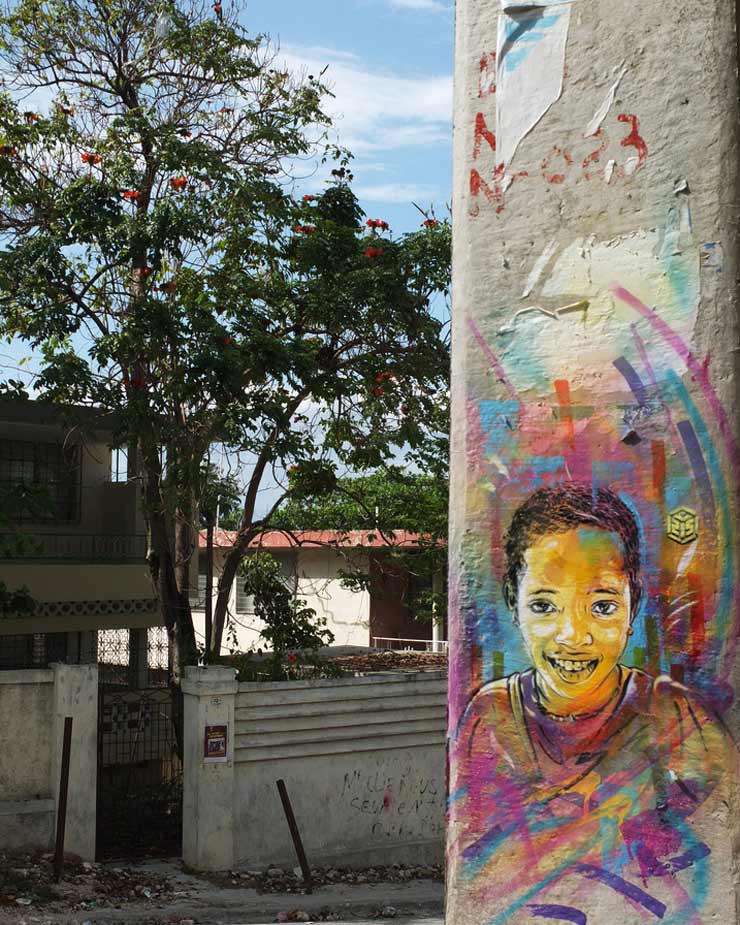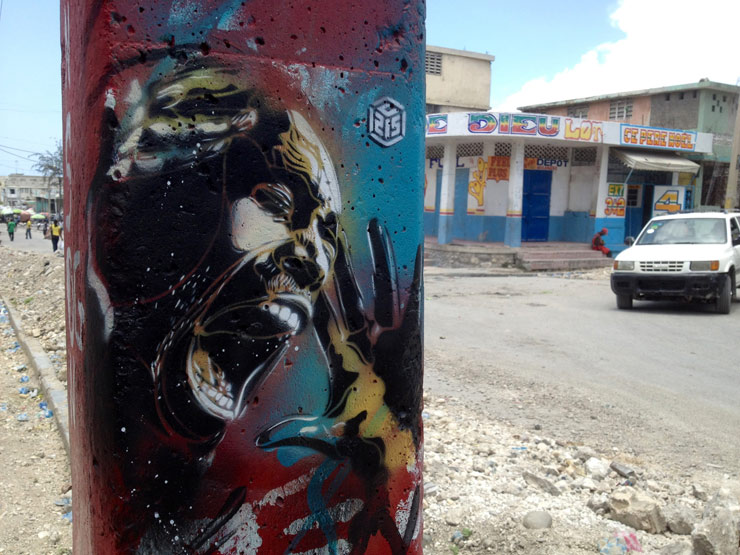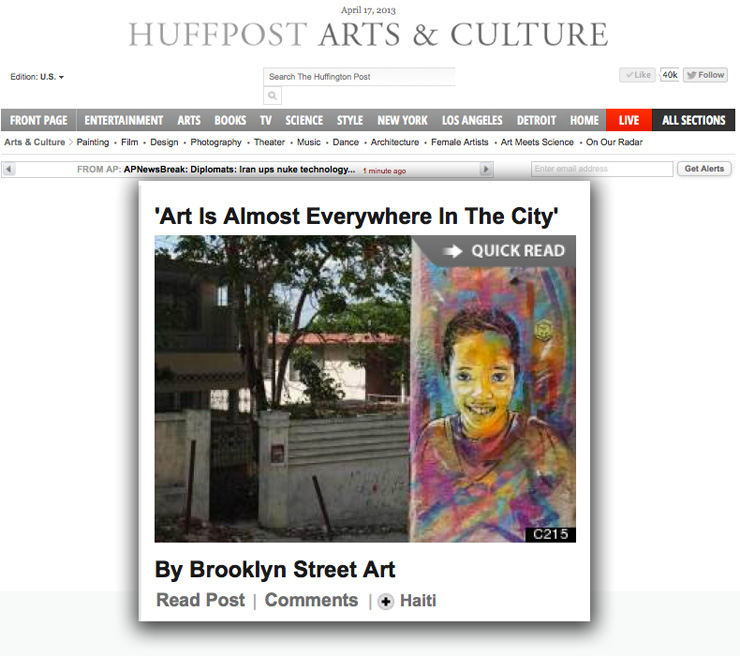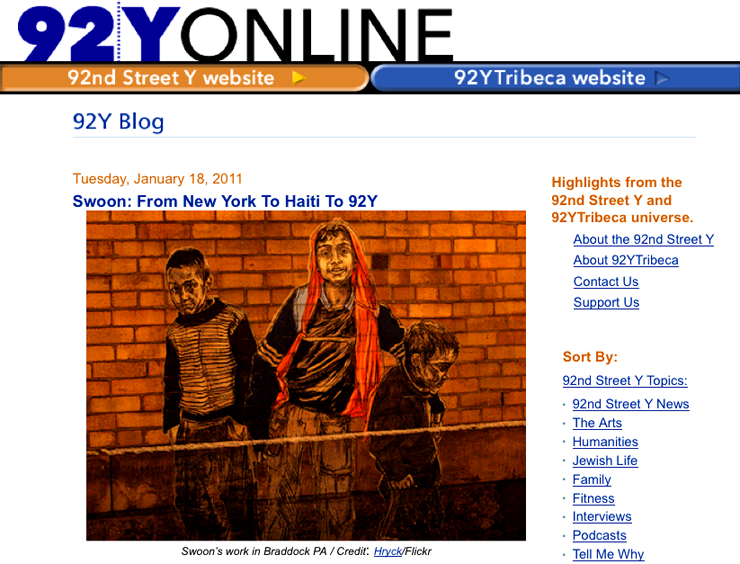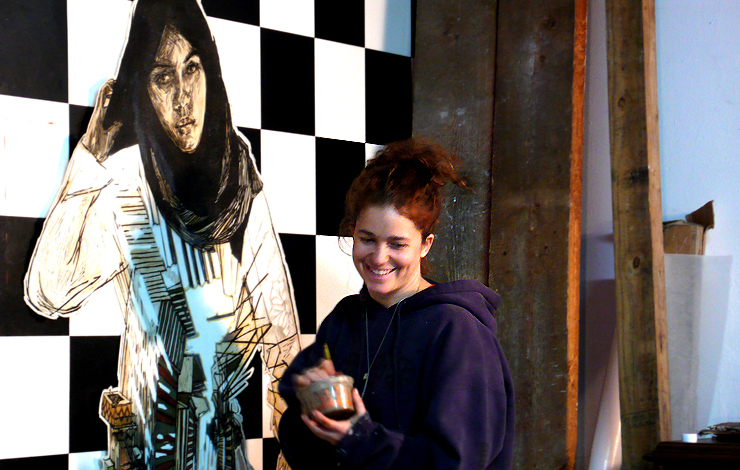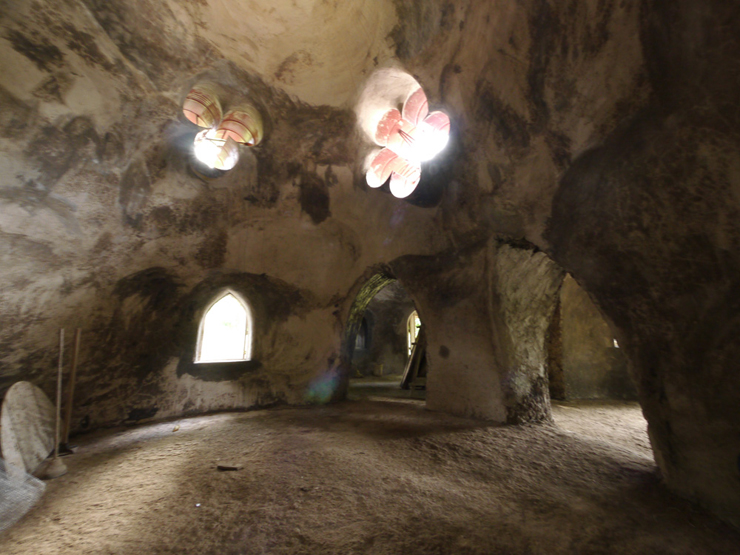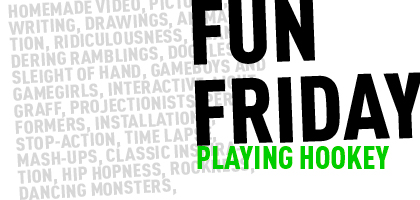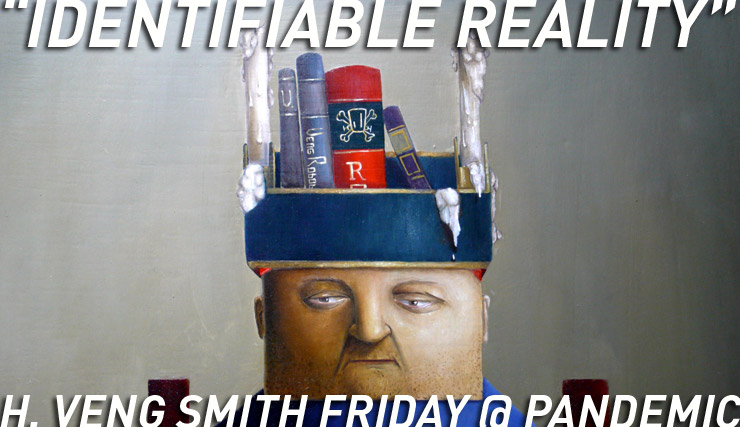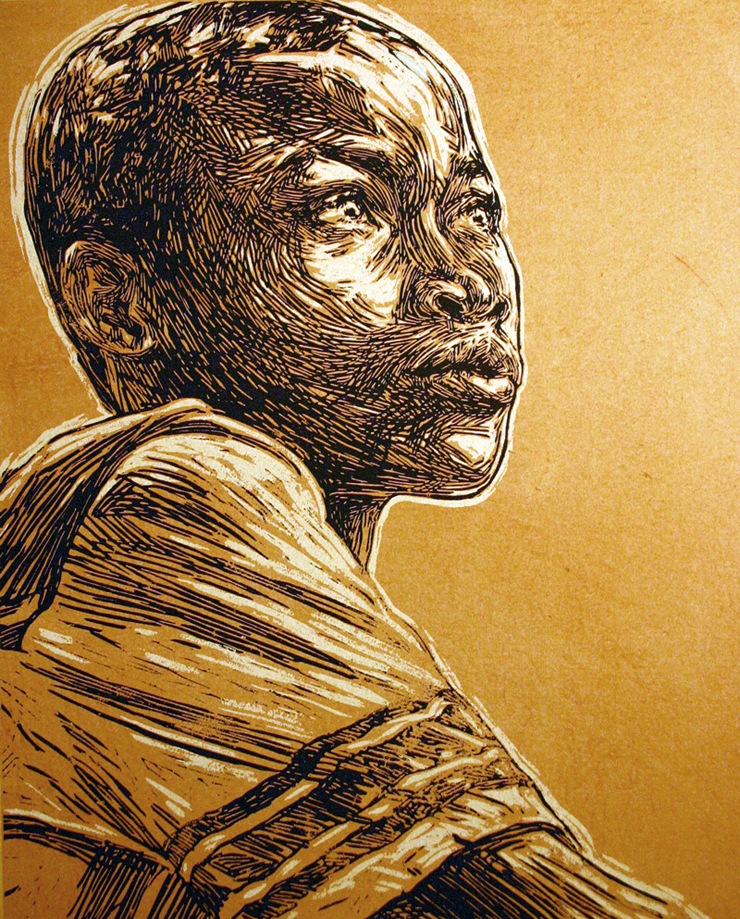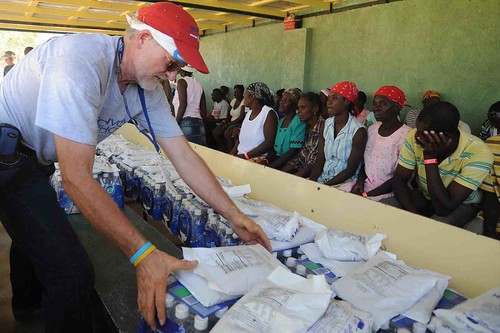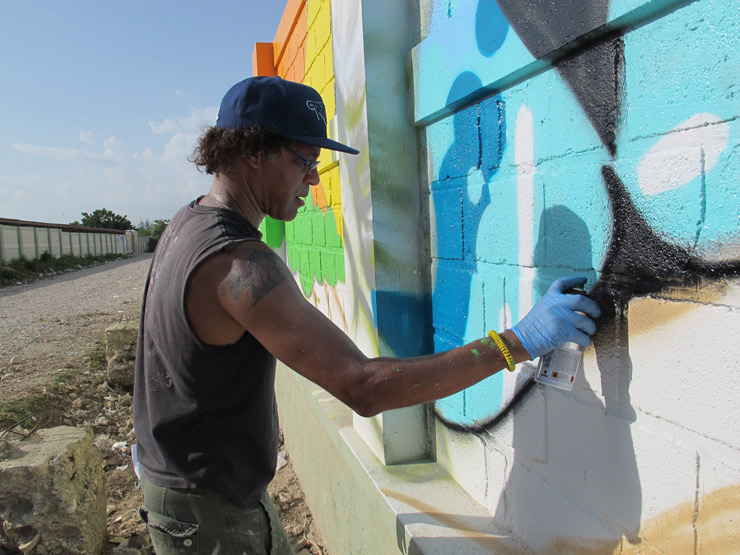
All posts tagged: Haiti

“The design that I came up with doesn’t deal with peace in a political or military sense, but is more about inner peace,” DAZE tells us. “I wanted to create something that would be offering a kind of inner peace in order to achieve further goals.”
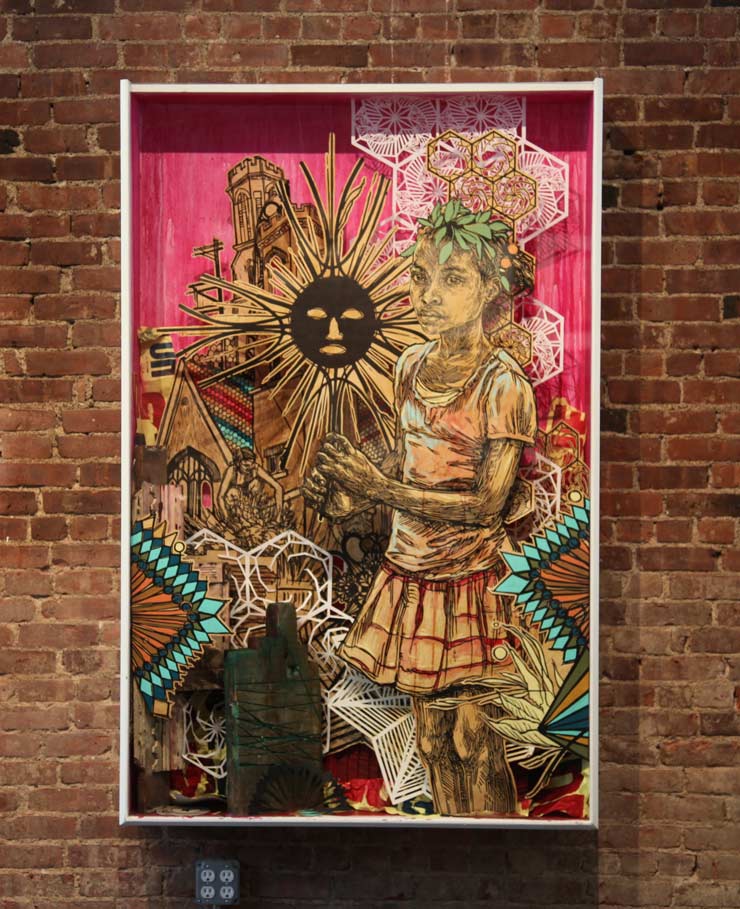
Swoon “The Road By Walking” and Artist Talk with BSA
An Inside Look at The Imagination and Energy of Swoon and “The Road By Walking”
This is how the road is made. Swoon invites you to take another step with her.
It’s been an enormous success this week for Street Artist Swoon as she launches her Heliotrope Foundation to bring the values and vision of her long-term community-based projects under one roof. Beginning with a packed private opening Wednesday with enthusiastic guests clamoring for a new print and to see a large selection of drawings, visitors also poked their heads around intricate small scale models of her centerpiece projects and into selfies with Swoon and Heliotrope board member Swizz Beatz.
Swoon. The Road By Walking. (photo © Jaime Rojo)
Since the earliest days of seeing Swoon’s wheat-pasted cutouts on New York streets passersby could tell that these waters run deep and are full of stories and a committed sense of our collective inherent responsibility to uphold our neighbor and to seek to re-balance.
The Road By Walking show allows you to personally contemplate the baseline commitment the artist is making to the fate of others whose lives have been struck by disaster – whether natural, as in the case of the earthquake in Haiti or the hurricane in New Orleans, or the man made economic disasters that leave communities worldwide suffering in their wake, as in the de-industrialized town of Braddock, Pennsylvania.
Swoon. The Road By Walking. (photo © Jaime Rojo)
Without lecturing or preening, Swoon consistently demonstrates how using your talents, whatever they are, can transform – first through imagination, then through boots on the ground. With very dedicated teams of volunteers and talents alongside, in front of and behind her, Swoon keeps making new roads.
The Road By Walking, which is again open today and free to the public, allows fans of street art and social activism an opportunity to come face to face with how small scale artistic interventions can plant and nurture seeds of lasting change.
Swoon. The Road By Walking. (photo © Jaime Rojo)
BSA is proud to invite you to meet the artist today as The Road By Walking culminates in an Artists Talk with BSA and Swoon at a special reception tonight, where we’ll be learning about her plans for Heliotrope Foundation and specifically about Braddock Tiles, The Music Box, and Konbit Shelter.
We can’t wait to meet you! It is a free event and space is very limited so please RSVP so we’ll know you are coming.
(Please see all the links at the end of this post, including the RSVP button and online bidding)
Swoon. The Road By Walking. (photo © Jaime Rojo)
Swoon. The Road By Walking. (photo © Jaime Rojo)
Swoon. The Road By Walking. (photo © Jaime Rojo)
Swoon. The Road By Walking. (photo © Jaime Rojo)
Swoon. The Road By Walking. (photo © Jaime Rojo)
Swoon. The Road By Walking. Maquette for Braddock Tiles Project. (photo © Jaime Rojo)
Swoon. The Road By Walking. Interior view of maquette for Braddock Tiles Project in Braddock, PA. (photo © Jaime Rojo)
Swoon. The Road By Walking. Interior view of maquette for Braddock Tiles Project in Braddock, PA. (photo © Jaime Rojo)
Swoon. The Road By Walking. Maquette for New Orleans Music Box Project. (photo © Jaime Rojo)
Swoon. The Road By Walking. Maquette for New Orleans Music Box Project. Detail. (photo © Jaime Rojo)
Swoon. The Road By Walking. Maquette for Knobi Shelter Project in Haiti. (photo © Jaime Rojo)
Swoon. The Road By Walking. (photo © Jaime Rojo)
Online bidding is still open! PADDLE8.COM/AUCTIONS/HELIOTROPE
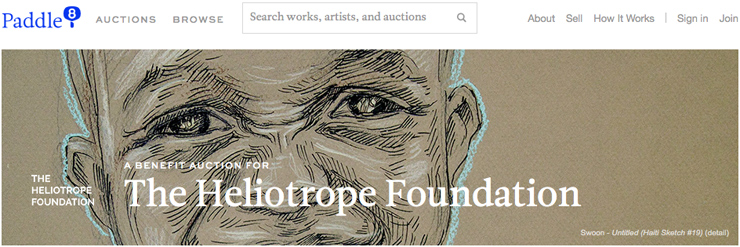
Please consider Donating to The Heliotrope Foundation
The Road By Walking
Benefit Gallery Show for the Heliotrope Foundation
May 13-16
287 Gallery
287 Tenth Avenue between 26th and 27th , NYC
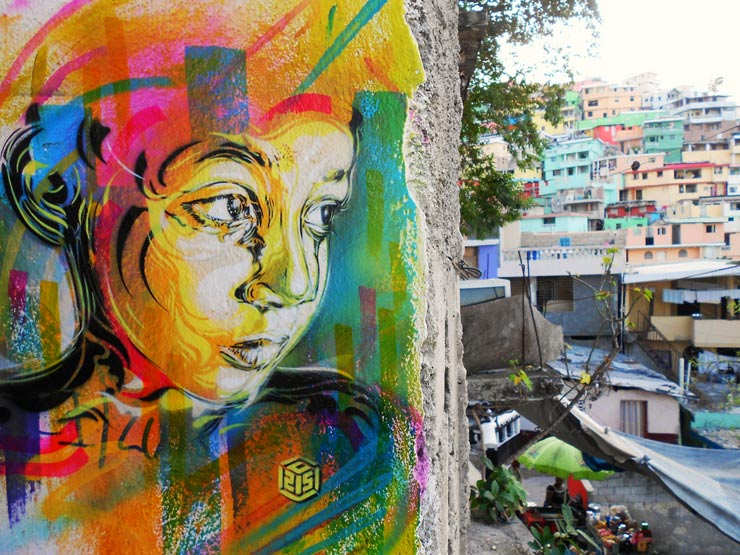
Stencil Street Artist C215 Explores Haiti in Full Color
Parisian Street Artist C215 has been traveling again, this time to Port Au Prince in Haiti, where he drew many curious audiences during the week-long visit to watch him create his evocative stencil portraits on columns, in doorways, along narrow walkways, on rooftops, and in streets.
“It was a very strong experience for me personally. I found it to be kind of a mix between the favelas of São Paulo and the suburbs of Dakar,” says the artist known for casting a light on homeless or otherwise disadvantaged citizens in cities around the world with his very personal stencil portraits.
C215. Port Au Prince, Haiti. April 2013. (photo © C215)
While in Haiti meeting new people and learning as much as he could about the culture on the streets, he also was learning about a small new urban art organization that has goals of one day throwing their own festival with invited international artists. “Aude Hulot of the Kasav organization is guiding me in this anarchic city,” he reports as he carries bags full of aerosol paint through a back alley.
Only a few years ago C215 made his name in the Street Art world with one or two colors, white and black. Often he did his work using only white. With some sort of empathy at hand, he developed an uncanny ability to convey part of the essence of the people he depicted simply through a quickly sprayed stencil on a doorway, or on a dumpster. That sort of honesty in depiction, not shrouded by edifice, made his spare figures almost jump from the mottled and rusted surfaces they appeared on. Since he first began there have been many who have observed that his work inspired a number of new Street Artist – each trying their hand at cutting and spraying portraits. It’s not a bad legacy to tell the truth, but you can sometimes guess that the imitation isn’t always interpreted as flattery.
C215. Port Au Prince, Haiti. April 2013. (photo © Viktor Gjengaar)
These days C215 is making some wildly varicolored departures from the single hue stencil that was once his signature. As he tells us in the interview below, a severe illness a few years ago caused his stark and haunting monochromatic images to suddenly become flooded with life, and without warning they became ebullient, even fantastic, in their audacious color combinations. Looking at the wide range of people he has just created on these walls in Haiti, you know that C215 is again setting a standard with his ability to communicate personality, emotion, ease, rage, fear, and a true humanity on the street.
C215. Port Au Prince, Haiti. April 2013. (photo © C215)
Brooklyn Street Art: How has your experience been in Haiti and what brought you here?
C215: A young woman living in Haiti, Aude Hulot, came to visit me in my studio one day in Paris and during her visit she asked me to come to Haiti to paint portraits in the streets of Port au Prince. She said she was part of a local arts association, Kasav and their goal is to promote urban art in the city – perhaps eventually to create a festival that attracts street artists to their city.
I was interested in experiencing and learning about the dramatic living situation of people in Port au Prince, and to see what has happened in the three years since the earthquake. Because I did not know if I would find a potentially dangerous environment or not, my good friend Viktor Gjengaar from Norway came along – he also helped to document the trip properly with photos and video.
C215. Port Au Prince, Haiti. April 2013. (photo © C215)
Brooklyn Street Art: Can you talk about how you prepared for the trip with your art materials.
C215: I came with a whole collection of Caribbean portraits, a few hummingbirds and tropical flowers, so that the local people could appreciate my art with local subjects. They all understood that way that what I was painting was a clear tribute to their culture, and not simply a Western marking on their walls.
Brooklyn Street Art: When you are selecting individuals for their portrait, what qualities are you looking for?
C215: I simply need to get inspired. I’m not looking for famous people; Instead I look for anonymous ones who anyone can identify with. I learned that it was important in Haiti that no portrait could be understood as a political or a religious message – to avoid possible arguments or controversy. Local citizens were also paying attention to my work to insure that none of the persons whom I painted was dead, because of a concern about the ghost’s spirits. This is part of a prevalent belief in Voodooism that is very strong there.
C215. Port Au Prince, Haiti. April 2013. (photo © Viktor Gjengaar)
Brooklyn Street Art: You could simply reprise one of your earlier stencils from other cities on the street here. Why do you make new ones for new locations?
C215: I mixed up old and new ones, but all them were fitting with the island spirit. I did cut two new portraits based on anthropological studies from the very early nineteenth century; the portraits were of a couple to be precise. As a way to evoke the slavery period I painted them next to bars. Haitian culture has deep memories of slavery and I wanted to pay a tribute to this sad memory.
C215. Port Au Prince, Haiti. April 2013. (photo © C215)
Brooklyn Street Art: Can you talk about the portrait of the kid with the gun in his hand?
C215: This portrait is based on an image by the famous photographer, Steve McCurry. I painted it in one of the wealthiest districts of Port au Prince as a way to evoke the economical and physical violence on the island. I hope it might also draw attention to the reality of street kids who are living in Port au Prince.
C215. Port Au Prince, Haiti. April 2013. (photo © C215)
Brooklyn Street Art: You have spoken before about your concept of your work in the street as community service. Do you feel that you have been providing a service to part of the community here?
C215: I participated in a fundraiser for Haiti in 2010 with Brooklynite gallery but I thought that going to paint by myself in the slums of Port au Prince was rather a social, if not political act. As time has passed I sadly see that nowadays street art is less and less dedicated to the “street people” and it is more often created for the possible collectors.
There are no street art collectors in Haiti, so I think that even though my work is represented by the wealthy Opera Gallery I would like to go paint in one of the 10 poorest countries of the world, and in some way this is a kind of a Community Service. Everybody around me was speaking, before my departure and during my stay, about the risks I was taking by going to paint in a city unfortunately famous for tourist’s kidnappings and murders.
I experienced the city as a street painter and nothing else: I stayed there one week, painting in almost all districts and especially the “red zone”, and I can say that nothing happened and that I felt no threat. So without offering too quick of a conclusion about the island, if Haitians are absolutely poor, I can personally say they like art and respect artists. I felt everywhere I was welcome and my art got a very good reception.
C215. Port Au Prince, Haiti. April 2013. (photo © C215)
Brooklyn Street Art: For many people, one mark of a successful street artist is when they pick the right location for their piece, and the context it appears in. What helps you decide where a piece should be?
C215: Instinct, experience, and the vision I have of the final result before beginning to paint. It is somewhere very technical. I am not looking for the best place to advertise, moreover that I usually paint very small portraits to stay discrete. I am looking for the best result.
Brooklyn Street Art: Your color palette has become so vibrant and full of color in the last couple of years. How has the experience been to using so much color?
C215: Colors became very strong in my works in 2009 after I caught meningitis in Morocco. I lied in complete darkness for one month and when dreaming I had the vision of portraits painted exclusively with very bright colors. I discovered the way to create the images in my dreams and this new palette has had an impact in the streets, making my portraits very eye-catching to people. Using all this color also means I’m taking a greater risk of getting caught that, since it takes longer to paint with many colors than a quick stencil in black or white. I enjoy adrenaline. It was a very good way to turn my works more singular. Now I go painting outside with several cans, but also acrylics, inks and varnishes.
C215. Port Au Prince, Haiti. April 2013. (photo © Viktor Gjengaar)
Also I am using color because I get very quickly bored of repeating the same process, the same technique … I know that many artists on the street like to repeat the same kind of work all their life long but this process could not fit with my personality. I have no idea what I will be painting in the next five years, or even if I will be continuing to paint.
Brooklyn Street Art: Has your line become more relaxed in recent years? It looks like it has a little more fluidity, perhaps more of a feeling of motion.
C215: It is a natural evolution. I pay a little less attention to realistic details and a little more to style. Colors helped me to go into subtle lining since my work is now less based on contrast and sketch effects. Many stencil artists work now in white or black and white in the style I had from 2007 to 2009, working on the same kind of subjects like old people, homeless or sad kids – from Portugal to Iran. So I am happy that this new colored style has helped me to create a distance from what is now a kind of “stencil school” or a global movement. Maybe one day I will come back to white stencils: I like to contradict myself.
C215. Port Au Prince, Haiti. April 2013. (photo © C215)
Brooklyn Street Art: When we think of the artist Gaugin and the impact that the colors of Tahiti had on his painting, do you think the climate and culture of Haiti influenced your choices of colors?
C215: When I was looking at pictures of the city during my research I was impressed by the vivid palette that Haitians use to decorate shops and buses; Art is almost everywhere in the city. I decided to blend in with the scene by using the same colors that I found in the city. Gauguin was looking for the “good savages” in the Pacific islands, but my research is different: I perfectly know that there are no “savages” anymore in this world, only human beings who are equal to me, but from different cultures.
C215. Port Au Prince, Haiti. April 2013. (photo © C215)
Brooklyn Street Art: You had an audience for many of these pieces while you were putting them up. Is it difficult to do the work while people are watching and joking and conferring and talking?
C215: I painted more than fifteen pieces in seven days and every piece took me approximately 30 or 40 minutes to complete. Every time a little crowd gathered to watch what I was painting and I tried to stay focused on my job. When finished, I would speak with one of the people watching so that the others could get an explanation regarding my activity.
Luckily for me Aude Hulot from Kasav always helped to explain to people in their own languages what was the meaning of my work in Port au Prince. I encourage artists who are interested in going to paint there to contact the Kasav association and I am sure they will find them to be a very great help. (http://www.facebook.com/ArtStreetVizyon).
C215. Port Au Prince, Haiti. April 2013. (photo © C215)
C215. Port Au Prince, Haiti. April 2013. (photo © C215)
C215. Port Au Prince, Haiti. April 2013. (photo © Viktor Gjengaar)
C215. Port Au Prince, Haiti. April 2013. (photo © C215)
C215. Port Au Prince, Haiti. April 2013. (photo © C215)
<<>>><><<>BSA<<>>><<<>><><BSA<<>>><><<>BSA<<>>><<<>><><BSA
Please note: All content including images and text are © BrooklynStreetArt.com, unless otherwise noted. We like sharing BSA content for non-commercial purposes as long as you credit the photographer(s) and BSA, include a link to the original article URL and do not remove the photographer’s name from the .jpg file. Otherwise, please refrain from re-posting. Thanks!
<<>>><><<>BSA<<>>><<<>><><BSA<<>>><><<>BSA<<>>><<<>><><BSA
This article also appears on the Huffington Post
Swoon Talks at the 92Y Tomorrow Thursday, January 20
In 2010, Brooklyn-based street artist Swoon traveled to Haiti as part of the Creative Time Global Residency Program and worked with communities in Port au Prince and Bigones to rebuild housing and community structures after the devastating earthquake last year. Hyperallergic reported on the the project’s recent inauguration in Haiti:
The project is a rebuilding initiative, which “uses dome-style structures and the super-adobe technique of earth bag architecture to create sustainable, inexpensive and dependable housing for the people of Haiti. While the structures are extremely resistant to natural disasters, they also have the major benefit of being comprised of 90% earth and requiring no specialized scaffolding and understructure to build — making it a viable option for the people of Haiti to continue building on their own once they learn the method.”
Swoon was one of six New York-based artists—along with Sanford Biggers, K8 Hardy, Emily Jacir, Maya Lin and Walid Raad—given the opportunity “to get off the race track” that is life in New York City and focus on their work in another part of the world. Maya Lin researched mass extinctions while visiting Ecuador, Egypt, and China, Walid Raad traveled to Beirut, Sanford Biggers visited Brazil to work with video; K8 Hardy made stops in Chile, Mexico, Brazil and Argentina to investigate fringe queer culture and Emily Jacir investigated activism in Italy.
This Thursday, January 20, all six artists will come to 92nd Street Y to share the stories, findings and lessons from their time abroad.
Click on the link below to read Brooklyn Street Art Studio Visit and Interview with Swoon on The Huffington Post:
http://www.huffingtonpost.com/jaime-rojo-steven-harrington/post_1551_b_807120.html
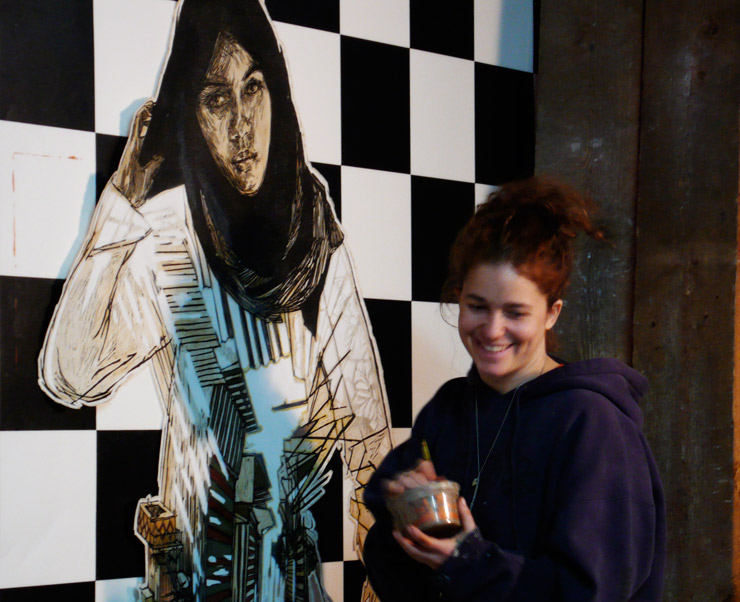
Swoon in Studio : A Warm Welcome on a Cold Night
A visit to Swoon’s studio is a full immersion into her passions; meditations on humanity, the process of collaboration, and sculptures you can inhabit.
Swoon adding color to the busy streets of “Cairo” (Sunday Afternoon) (photo © Jaime Rojo)
In the rustic warm light of a triple height cavernous space that might have served as a town hall a score of printed artworks on paper lay scattered across the wooden floor. Tiptoeing between the images to cross the formerly grand chamber, the familiar faces of children and adults who you’ve met on walls across the city look up at you. Together these figures, a de facto retrospective of Swoons’ last few years on the street in NYC, are burned into the retina of many a Street Art fan, and yet they lay here on this whitewashed wood-slatted floor without any ceremony at all.
Photo © Jaime Rojo
Around the rooms’ periphery a handful of assistants listen to music, straddle ladders, and attentively stroke warm earth tones on pieces taped to the wall. A rustling cold wind from the black New York night outside is blocked by clear plastic stretched across the windows, buffeting the draft. Swoon, one of Brooklyn’s most celebrated street artists, sits on her knees in the warmly lit room, jar in hand, adding shades of ochre to her piece, “Cairo (Sunday Afternoon)”.
Swoon: So can I just be over here painting?
Brooklyn Steet Art: Yep, wherever you like to be.
Swoon is at ease and at home here in the studio (photo © Jaime Rojo)
Within a couple of days she’ll fly to the west coast to plan her installation of a large interior sculpture, possibly housed in it’s own room, for the upcoming “Art in the Streets” exhibition at the Los Angeles Museum of Contemporary Art with it’s new director and her former gallerist Jeffrey Deitch. Days later, while New York suffers one of it’s worst snowstorms in years, she’ll return with a team to Haiti to begin laying the foundation of the first Konbit House for a woman named Monique and her two daughters as part of the second installment of the Konbit Shelter Project. But tonight she is relaxed and buoyant in this homey hearth of communal activity. This is the beehive environment that she invokes repeatedly throughout her creative life and processes, and one that buzzes with easy conversation.
An assistant works on “The Girl from Ranoon Province” (photo © Jaime Rojo)
Thai food’s just been ordered for the team and in a few minutes everyone will sit at a long makeshift table happily trading stories about the rumored ghosts living in this old building, the Underground Railroad that ferried slaves through Brooklyn, and the coming Wikileaks revolution. But for now we both crouch low on the creaking boards, sometimes kneeling, sometimes sitting cross legged, and talk about whatever comes to mind.
Brooklyn Street Art: I was thinking about how you talk about this internal world in your work being a world that you have dreamt about or you do dream about. And I was thinking about the fact that a lot of peoples work is autobiographical. What part of you is in here?
Swoon: Well you know it depends with each piece. This one is very literally “I went for a walk and I drew it”. Some pieces are much more about bringing together various symbols and some pieces are very much an impression transferred. Sometimes they can be a little bit like a travelogue. This is kind of a sensory recording of a place. And I think that in the form that I bring them together it is a little in that layered, kind of confusing state of dreams. Otherwise I think it’s pretty straight-forward.
As she speaks and dabs the brush in a tub of hand-mixed hue she appraises the urban pathways she has created in the robes of the woman in the piece.
Brooklyn Street Art: Sometimes places are confusing anyway on their own.
Swoon: Totally.
Brooklyn Street Art: So maybe you capture some of that confusion too.
Swoon: Yeah (chuckles), and I really am attracted to those places; Those kind of winding labyrinth-like cities and all of those places. I feel like I’m always kind of looking for them.
Three of Swoon’s street pieces in the process of hand coloring (photo © Jaime Rojo)
Brooklyn Street Art: What are you dreaming about these days?
Swoon: Hmmm, well I guess I’ve started a lot of dreaming about building things. Which is unusual I guess finally because…
Brooklyn Street Art: Maybe it’s because you’ve been building things!
Swoon: (Laughs) Yeah like it’s finally coming through! No, but really like the problem-solving process. Like, “I’m trying to put this roof on!”– which weirdly never happened.
She refers to the first Konbit Shelter she and a team completed in Haiti as part of an art installation/ sustainable housing project she spearheaded in 2010 as a response to the earthquake which shook the nation one year ago.
An assistant works on “Sambhavna” (photo © Jaime Rojo)
The conversation quickly reminds her of word she’s today received that gives her the go-ahead for a brand new project of a similar nature in Brazil.
Swoon: I just got news yesterday that there is a new project, that I’m pretty excited about, is going to be possible.
Brooklyn Street Art: Excellent! Congratulations.
Swoon: There’s these people in Brazil who are organizing this project with this museum and one of the things that was sort of part of the goings-on in this neighborhood is this train station. It is getting cleared out because there are a lot of homeless people living in this station. And I was like, “What’s happening with the train station? What’s happening with everyone?” And the guy was like, “ Well, they’re going to a shelter”. And then I was thinking about how sometimes people don’t like to go to shelters.
Brooklyn Street Art: Right, a lot of times they avoid them.
Swoon: And so I remembered that I had seen this place in Miami called Umoja Village – it was a thing where this group of activists had found a law on the books in Miami that (said) you cannot be arrested for taking care of your basic life necessities. And so they took it one step further and said, “We’re going to organize people to take care of their basic life necessities together” – so you don’t have the vulnerability of sleeping outside by yourself, you don’t have access to services, you don’t have access to healthcare, all of these things. So they organized people together into this village and they were still sort of independently living in their houses that they had put together. – But they had access to counseling, and they cooked meals together ..
“Sambhavna” and “The Girl from Ranoon Province” (photo © Jaime Rojo)
Brooklyn Street Art: So city services eventually did enjoin them at some point?
Swoon: Not really, no, it was pretty much an independent initiative and it had some resistance, and then some support. And I actually haven’t, I need to find out for curiosity, found out what their current status is. So anyway, I think that we are actually going to join up with some people in Sao Paulo and actually work on creating a crazy sculpture which at the same time can function as optional housing for people who are getting moved out of the train station. And they said they would bring on some community organizers, some mental health people, and build a kitchen.
Brooklyn Street Art: Thank God.
Swoon: And there will be like..
Brooklyn Street Art: Fire codes, little things like that?
Swoon: Actually fire was a really big problem with Umoja so that was a really good thing that you bring up because that thing burned down. So that is something that we really have to consider.
Detail of “Sambhavna” (photo © Jaime Rojo)
“Sambhavna” in the wild. A street birthday gift to a friend that lives nearby. (photo © Jaime Rojo)
The introduction of a new project that includes a sculpture that people can live in? A collective that coalesces around constructing it? Why does this new project sound so familiar? Her street art figures are often singular, but Swoon’s process for creation is more often than not colorfully collaborative. The thought of getting an approval for this new idea frightens her a bit, as the beginning of any huge public/private art initiative can summon fears of complications and quagmires. After talking for a few minutes Swoon notes that she’ll have help from many differently talented individuals for this new live-in scultpure, and that makes her happy.
Brooklyn Street Art: Do you think it might serve as a model for something else in the future?
Swoon: I think everything you do does, for better or worse. I mean, it will, if it works. It depends on what happens. I mean it could serve as a model that says, “Okay that was a total disaster”
Brooklyn Street Art: Here’s something to avoid!
Swoon: Don’t ever do that again! Or it could be, “this thing worked and let’s think about it some more”
Brooklyn Street Art: Well, it seems like it is kind of like the Konbit Shelter Project idea, right? You’ve completely put it into place with the collaboration of a number of different people and talents.
Swoon: Yeah.
Brooklyn Street Art: And it is serving as maybe a template for this future work?
Swoon: I think maybe so, as far as small groups working in a certain way. And of course you know we took a template from someone else.
Brooklyn Street Art: I see.
Swoon Konbit Shelter. Bigones Village, Haiti. Photo courtesy Upper Playground © Tod Seelie
Swoon: We borrowed this engineered architecture style and so it’s like we took some working processes and we wanted … I think ours was almost a thought process too. Like, how can you, as an artist who isn’t a big NGO, that isn’t an aid organization, still be involved in a way that is offering something permanent?
Brooklyn Street Art: Have people from NGOs taken an interest and inquired about the project in Haiti?
Swoon: I think a little bit. Yeah, not a ton.
Brooklyn Street Art: Those buildings you created look like beehives to me. Where does “Konbit” come from?
Swoon: That word is an awesome word that is apparently pronounced like “Coom bee” and it
Brooklyn Street Art: I think I understand, is it like a combination?
Swoon Konbit Community Center Inside. Haiti. Photo Courtesy Upper Playground © Tod Seelie
Swoon: No, I think it’s a Creole, or I think it’s a Haitian word, and what it means, what it refers to is the time when the harvest is ready and there is usually too much work for any one person to do, people will cooperatively harvest each others farms together. So it is the word that means working together cooperatively when things need to get done. And we were like, “That’s beautiful. That’s really what we want to try to do.”
Brooklyn Street Art: You had like thirty people working together.
Swoon: Totally. And I think it’s about the US and Haiti, and starting to make that partnership that way as well.
Brooklyn Street Art: You feel like it’s been a good partnership so far with the US and Haiti?
Swoon: Well…. (laughs), with us and that village – it’s a really good partnership. I don’t mean that in the political boundaries sort of way.
Photo © Jaime Rojo
Swoon. One of her most popular pieces on the street. (photo © Jaime Rojo)
Brooklyn Street Art: So it occurs to me that with so many of your large expansive art projects what you have been doing is creating giant sculptures that people can live in or interact within.
Swoon: That’s starting to happen, yeah
Brooklyn Street Art: Well even in the Swimming..
Swoon: Oh, the boats!
Brooklyn Street Art: Yes the boats, and in these shelters, and when one is walking into your exhibits, like the one at Deitch – you feel like you are walking through sculpture and around it, interacting with it, seeing through it. And then I think of the work of Gordan Matta-Clark and those buildings that he turned into sculptures and it is amazing how no matter how many different projects you are doing there is a narrative thread that goes through all of them.
Swoon: Yeah, I sometimes get that crisis of ; “How is this related?”, but I don’t really live in that for very long. I’m just like, “whatever”, it will become apparent. Because it doesn’t really matter, it doesn’t have to be related. And then in the end it’s related anyway.
A view from above (photo © Jaime Rojo)
Brooklyn Street Art: A lot of Street Artists, as you know, prefer to work singularly. – They like to hide out in caves and do their work, secretly run out, put it up, and run back in. But this room has many people working in it. You are always working collaboratively.
Swoon: Yes a lot of the time. My drawing, I do by myself. This, what we are doing, is the painting, the sort of “afterwards”. But the drawing I have to do by myself for sure. It’s more focused. I can’t really get to that kind of focus if I’m around other people.
Brooklyn Street Art: Do you draw daily? Weekly?
Swoon: It depends on what’s happening. Daily if I can, and then sometimes I won’t draw for two months.
Brooklyn Street Art: Did you get a lot of drawing done when you were in Haiti?
Swoon: None. We were like, dead tired every single day. You know, it was like, “Up with the sun”, and then you would get home and you’d be like, “Oh my God Paypal has frozen our funds!” And then you would email for four hours figuring out how to deal with that crisis, and then try to put a picture up on your blog and fall on your face and sleep, so I didn’t do drawing.
Detail (photo © Jaime Rojo)
Brooklyn Street Art: It is back breaking work, but you had your creature comforts…
Swoon: We did actually, at that place. This next time around we’re going to be living in the place where we built. It’s now a community center so right now no one is actually living there at night. So I think that will be better because before we were staying at this nice house a little bit outside of the village, which was nice because we had the Internet. But I’m looking forward to staying in the village.
Brooklyn Street Art: Is the first Konbit Shelter going to be used as a community center? Is that still being debated about what to use it for?
Swoon: I think that it is slowly… because there isn’t any furniture in it, and we didn’t paint it. It can be used. But I feel like it’s not fully embraced yet. So I think once we go back and really put the finishing touches on get started on another house then it will be a little more.
Brooklyn Street Art: I haven’t seen much of your work on the street recently.
Swoon: I haven’t done anything on the street in the City in a long time.
Brooklyn Street Art: Maybe in the spring time?
Swoon: I’ve gotten into a weird thing where I neglect New York entirely.
Brooklyn Street Art: You’re done with it maybe?
Swoon: No, maybe it’s because when I’m home I’m so busy. There’s definitely something going on though, there is some neglect.
Brooklyn Street Art: When you come to New York you are all about work, no play.
Swoon: Kind of. In a bit of a sad way actually. I don’t really have friends here anymore. I just kind of blow through.
A large collaboration in the Wynwood District of Miami with Ben Wolf in 2009 (photo © Jaime Rojo)
Brooklyn Street Art: What about Florida?
Swoon: No I just go to the ocean when I’m there, and hang out with my little brother. Otherwise Florida is my little zone home.
Brooklyn Street Art: Well that piece that you did in the Wynwood District last year is still there.
Swoon: Yeah that big mural?
Brooklyn Street Art: On that rounded corner of a building…
Swoon: It’s pretty weird. It was fun doing that, I mean it was fun learning. It’s a bizarre mural in every way, but I’m glad we did it.
Brooklyn Street Art: Me too, I’m glad it still looks good, wasn’t destroyed.
Conversation quickly turned to the Thai food delivery that presently arrived. Everyone jumped from their perches on ladders and stools and knees to arrange themselves around a table to share a meal and many lively stories. With Swoon in attendance, there will surely be many stories to come.
With very special thanks to Heather Macionus.
Read more about the new Swoon print for the Konbit Shelter from Upper Playground.
Donate the the Konbit Shelter Project via Paypal
Photo © Jaime Rojo
Fun Friday 12.17.10
Fun Friday
Bing and Bowie Reunion 2010!
To put you in the right spirit for your holiday shopping and spray painting, BSA reader Jodi has alerted us to this charming holiday classic, remade by two of today’s singing sensations! Grab your cardigan and pipe!
Veng from RWK Flies Solo
Detail of “Jerome”, by H. Veng Smith (photo © Jaime Rojo)
H. “Veng” Smith “Identifiable Reality”at Pandemic
BSA Interview with H. Veng Smith this week.
Legacy of Letters
Luca Barcellona really impresses with his command and his almost choreographic hand style at calligraphy. Sit back and enjoy on this fun friday.
New SWOON “Walki” Print
As she readies to return to Haiti (interview next week), Swoon is offering a new print to support The Konbit Shelter Project.
“The Walki print is an immediately touching portrait by Swoon of a boy named Walki who lives in the village of Bigones and spent time with the Konbit Shelter team at the community center building site this last summer. The print is made of a three-layer screenprint on handmade Indian jute paper measuring 13″ x 21″ and is limited at an edition of 300 – all proceeds from the sale will go towards support of the Konbit Shelter Project.
The Konbit Shelter Project was created with the idea that a group of artists, engineers, architects and builders could pool their individual knowledge, resources and time to make a lasting difference in post-earthquake Haiti”
Learn more here at Upper Playground
Looptaggr: Endless tags on the Run
BSA Technology and Art UPDATE: This weekend the new Tron movie comes out to thrill and chill techno geeks everywhere. Apparently they took 28 years off of Jeff Bridges with new developments in CGI. I’ve pre-ordered the personal CGI device coming out this spring by Apple – the iDigress personal age reducer should enable me to jump fences and run through empty lots with more agility. Speaking of Hi-Tech wizardry, take a look at the new LoopTaggr, which really cuts down on your stenciling time.
Swoon: From Haiti With Love
Brooklyn based Street Artist Swoon has been in Haiti for the last few weeks helping re-build the community and bring in alternative ways of constructing housing and shelter. The project involves the residents of the village of Barriere Jeudy in the process.
To get the work done Swoon is there with a small team of friends and like minded individuals; Tod Seelie, KT Tierny, and Ben Wolf.
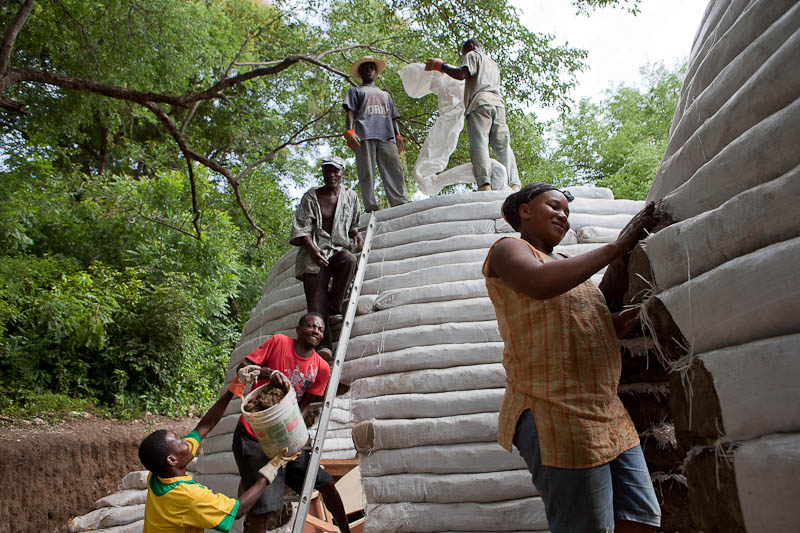
-
Photo © Tod Seelie

Photo © Tod Seelie
In a brief dispatch she just sent, Swoon talks about the project:
I’m writing from Haiti. I’m here with Tod Seelie, KT Tierny, and Ben
Wolf. For the last three weeks we have been building a community
center/hurricane shelter with the participation of the village of
Barriere Jeudy.This first structure is being created to give a meeting place to the
mango growers, and other local residents, as well as to introduce some
alternative building styles as Haiti rebuilds itself after the
earthquake.So far, we’ve been able to provide temporary jobs for about 60 people,
as well as train three teams of builders in the earthbag technique. If
all goes well, we’ll be finishing within a week or two, and returning
to build some houses in the fall.
If you have interest in the project and would like to learn more about it and MAKE A DONATION please go here:
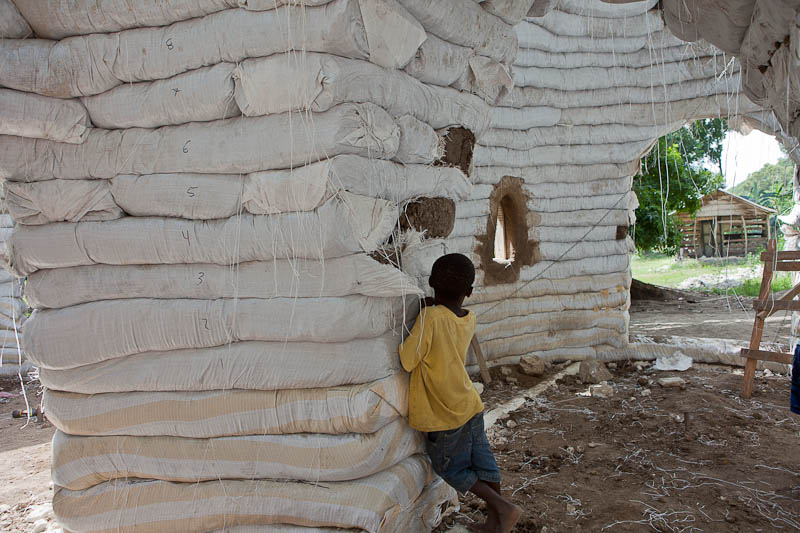
-
Photo © Tod Seelie

Photo © Tod Seelie
“I HEART HAITI” T-Shirt Gives 100% to American Red Cross
Here’s the deal:
You Give $25 to the Red Cross = Billi Gives You a T-Shirt
Since the January 12th earthquake we’ve seen lots of neighbors jump on board to help the people of Haiti. Hell, Lou A. even went there to help in person. (Go Lou!) Brooklyn hurts when Haiti hurts, and it’s been fantabulous to see a lot of artists really put their hearts where their mouth is.
Having a heart for Haiti is one thing, but it’s also important to “walk the walk”, says Street Artist Billi Kid, and you have to agree with him.
We do. That’s why we’re helping him and telling you about this fundraiser.
The project is called “I HEART HAITI” – seems simple enough, and we’re glad to see that the artist has figured out a way to give 100% of the profits to the people who are hurting.
These three companies have generously donated their time and services
Alternative Apparel ,
The Shirt Factory , and
The Public Works Department
Here’s the website http://www.ihearthaiti.us/
The I HEART HAITI website is LIVE and they are ready to take your order for Men’s and Ladies styles in 4 different sizes.
PLEASE SEND THIS LINK TO YOU FRIENDS, Twitter it, FaceBook it, Text it, and send your grammy a nice hand written letter. She probably deserves one anyway even if you don’t mention the tee-shirt.
*****************************
Brooklyn Street Art: So, how did you conceive of the design for the shirt?
Billi Kid: I’ve always been a fan of Milton Glaser’s “I Heart NY” tee. Honestly, it was the first thing that came to mind. The message is simple, yet resonates to the core of how we should feel about Haiti right now.
Brooklyn Street Art: It seems like it’s really nice quality….
Billi Kid: Alternative Apparel’s tee is of the highest quality and feels like butter. It’s 100% pure Egyptian cotton and retails for $19.95 without the silk screened artwork.
Brooklyn Street Art: Isn’t it hard to get partners to do the production and shipping for a project like this?
Billi Kid: I have to give all of the credit to the Public Works Department. They brought in all of the partners involved. All I did was design and produce the artwork and website. No small feat, but it felt good doing it. One of the great things about unemployment is you have lots of free time. LOL
Brooklyn Street Art: You are not a major corporation – how did you manage to give 100% of the proceeds to Haiti?
Billi Kid: Again, PWD has all of these great relationships with the folks involved. Fortunately, they all wanted to donate to the best of their abilities. The Shirt Factory printed over 12 dozen tees at no cost and pledged to do more if our efforts are successful. I’m sure what we raise is just a drop in the bucket, but every little bit counts.
Brooklyn Street Art: Can you talk about the aid organization you’re working with?
Billi Kid: We decided to give all of the donations to the American Red Cross because they seem to be the most legitimate and involved charity out there. Unfortunately, they protect their brand to such a point that they asked us to take their logo off our website. No hard feelings though, we have all heard how people rush to profit from such tragedies. OUCH!
 Brooklyn Street Art: People in Haiti are living under a piece of fabric, or plastic. How long do you think they will continue to need help?
Brooklyn Street Art: People in Haiti are living under a piece of fabric, or plastic. How long do you think they will continue to need help?
Billi Kid: I have heard it said that this tragedy was not an act of nature, but rather an act of poverty. It will take decades before we see real progress from this earthquake, let alone their economy.
Brooklyn Street Art: Anything else we should mention?
Billi Kid: I have to give a shout out to BSA. I Heart BSA!!!
<<<< > < > < >< >>>>>>>>>>>> <<<< >>> < >>>
Photo credit: Please see Aash J’s Flickr at http://www.flickr.com/photos/aashj/sets/
How Much Do You Give? How Much Do You Have?
We’re all getting hit from all directions about the need from our Haitian brothers and sisters for help. Suddenly our worries about our own economy are less important when we know people are actually suffering.
While we keep hearing on the news and from some friends who are there that the logistics of landing at a broken airport, driving through broken “roads”, avoiding buildings that are waiting for one more tremor before crumbling, and about the aid getting stuck in bottlenecks while people languish, we also hear good news here and there.
In a media-soaked society that has very short news cycles and attention spans, I only hope that the helping hand from us continues for as long as they need it.
Artists can be a pretty self-centered lot, agreed. I’m as narcissistic as the next one, sometimes. But as a community, time and again we have seen artists put their entire heart out there to help, and there are countless individuals and groups in this city who are organizing to help right now. Since Brooklyn has one of the largest Haitian communities outside Haiti, we feel the sadness especially hard, and the love too.
So please don’t tire of the news before the need is over. We’re going to keep bringing it up.
One street artist and stencil artist, Joe Iurato from New Jersey sat at the edge of his bed the other night contemplating all the simple things he had to be thankful for and decided to reach out by fundraising via Facebook to sell prints he made and send the profit to UNICEF. He called it “Spray for Haiti”. He did it “because I have absolutely zero tolerance for watching a child suffer under any circumstance”. He sold them all within minutes.
Joe didn’t wait around – he designed another and marketed that one just via email. The seven layer cut stencil sold out in a short time. Along the way, he discovered more generous people than he thought were there, and he’ll gladly tell you stories, though we won’t recount them here.
The main point is, no one had to tell Joe to use his talents to help others. He just did it.
Mr. Brainwash Splashes Mondrian for Haiti
As usual, the artist community has jumped in feet-first to help others by donating their work.
Mr. Brainwash, who is having a show next month in New York in a 15,000 sf space in the Meat Packing district of Manhattan, is donating a portion of the sales of his new print to the Red Cross.
The eight color screen print and spray paint pieces are on archival art paper. Each print is hand finished, signed, and numbered by the artist – with a thumb print on the back too for additional authenticity and the personal touch.
A portion of the proceeds from each print sold will be donated to the Red Cross for Aid in Haiti. Click on the picture to go to the site – The Print will go on Sale January 20 .
Help in Haiti: Ways to Help Relief Effort
“Brooklyn is the ‘Caribbean Capital of America’—by some counts, we have the largest Haitian population in the United States—and our hearts go out to our Haitian brothers and sisters in need,” said Borough President Marty Markowitz and Deputy Borough President Yvonne Graham.
“Brooklyn and Haiti share the common motto ‘In Unity There is Strength,’ and Brooklynites have been united once again—as we were in 2008 following a series of devastating hurricanes and a tropical storm—in opening up their hearts, wallets and pantries to the victims of this catastrophic earthquake. Our office will be working closely with the Caribbean community in the days ahead to lend support to Brooklyn and New York City-based relief efforts.”
- The American Red Cross is pledging an initial $200,000 to assist communities impacted by this earthquake. They expect to provide immediate needs for food, water, temporary shelter, medical services and emotional support. They are accepting donations through their International Response Fund.
- UNICEF has issued a statement that “Children are always the most vulnerable population in any natural disaster, and UNICEF is there for them.” UNICEF requests donations for relief for children in Haiti via their Haiti Earthquake Fund. You can also call 1-800-4UNICEF.
- Donate through Wyclef Jean’s foundation, Yele Haiti. Text “Yele” to 501501 and $5 will be charged to your phone bill and given to relief projects through the organization.
- Operation USA is appealing for donations of funds from the public and corporate donations in bulk of health care materials, water purification supplies and food supplements which it will ship to the region from its base in the Port of Los Angeles. Donate online at www.opusa.org, by phone at 1-800-678-7255 or, by check made out to Operation USA, 3617 Hayden Ave, Suite A, Culver City, CA 90232.
- Partners In Health reports its Port-au-Prince clinical director , Louise Ivers, has appealed for assistance: “Port-au-Prince is devastated, lot of deaths. SOS. SOS… Temporary field hospital by us at UNDP needs supplies, pain meds, bandages. Please help us.” Donate to their Haiti earthquake fund.
- Mercy Corps is sending a team of emergency responders to assess damage, and seek to fulfill immediate needs of quake survivors. The agency aided families after earthquakes in Peru in 2007, China and Pakistan in 2008, and Indonesia last year. Donate online, call 1-888-256-1900 or send checks to Mercy Corps Haiti Earthquake Fund; Dept NR; PO Box 2669; Portland, OR 97208.
- Direct Relief is committing up to $1 million in aid for the response and is coordinating with its other in-country partners and colleague organizations. Their partners in Haiti include Partners in Health, St. Damien Children’s Hospital, and the Visitation Hospital, which are particularly active in emergency response. Donate to Direct Relief online.
- Oxfam is rushing in teams from around the region to respond to the situation to provide clean water, shelter, sanitation and help people recover. Donate to Oxfam America online.
- International Medical Corps is assembling a team of first responders and resources to provide lifesaving medical care and other emergency services to survivors of the earthquake. Donate online.
AMERICAN RED CROSS
Text “HAITI” to “90999″ to make a $10 donation.
2025 E Street, NW
Washington, DC 20006
(800) REDCROSS (733-2767)
Special reporting from BoroughingBrooklyn.com and The HuffingtonPost.com
 BROOKLYN STREET ART LOVES YOU MORE EVERY DAY
BROOKLYN STREET ART LOVES YOU MORE EVERY DAY
